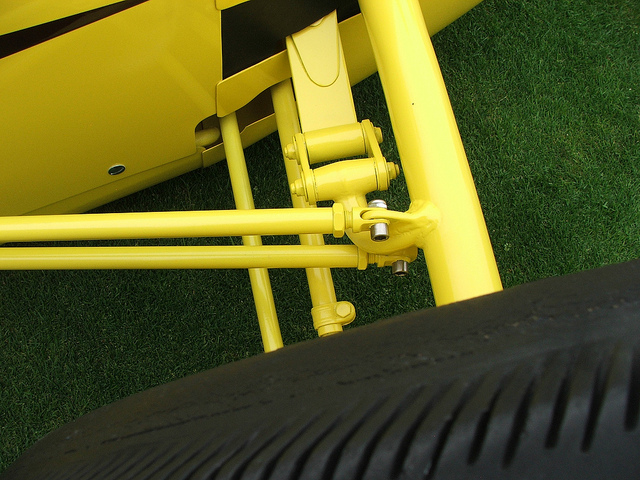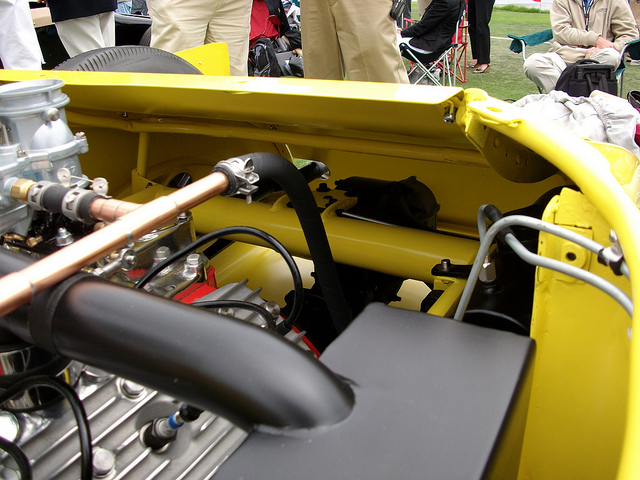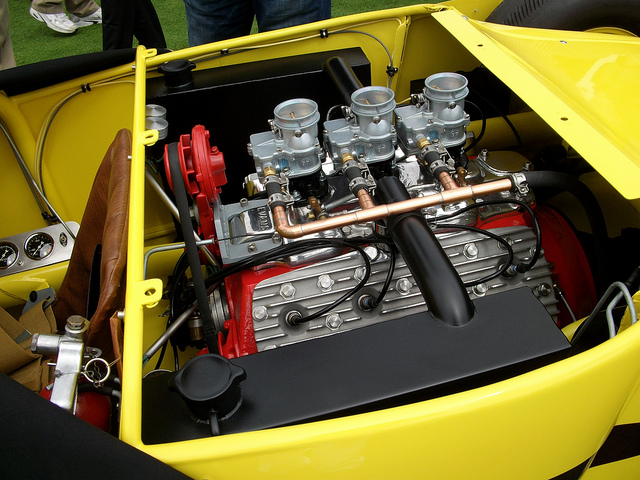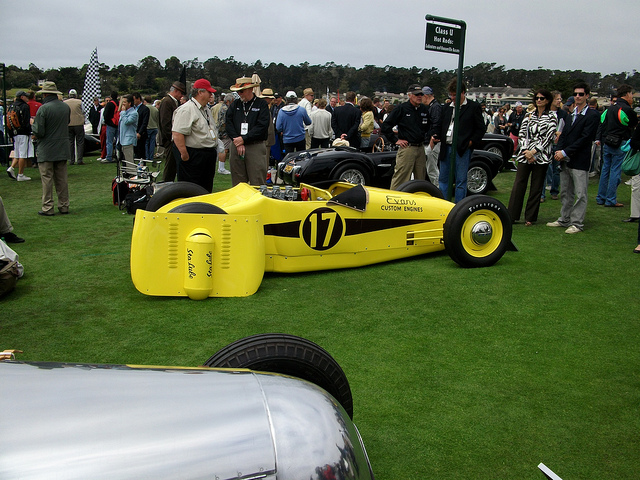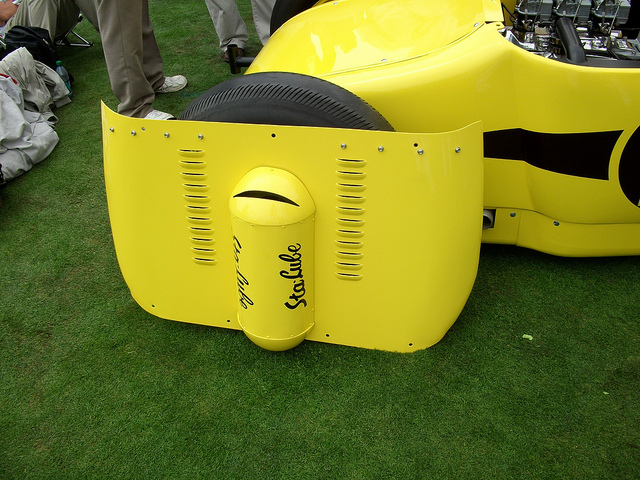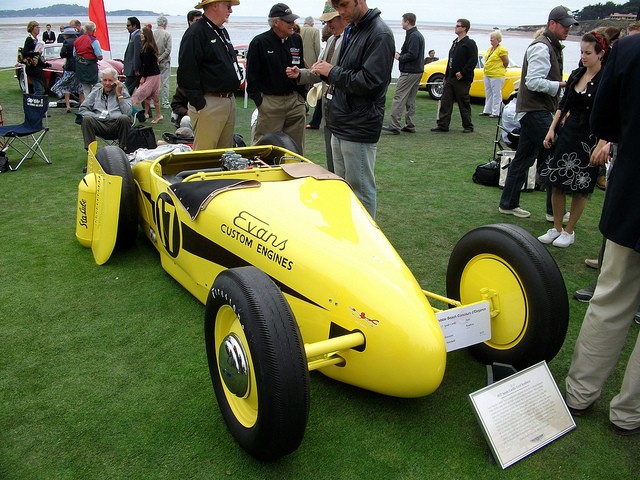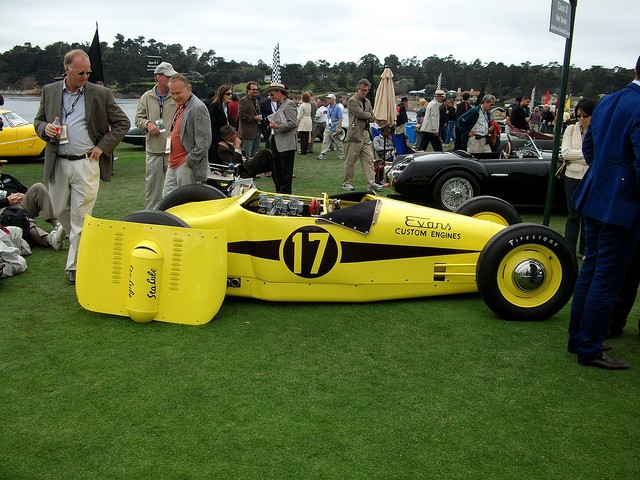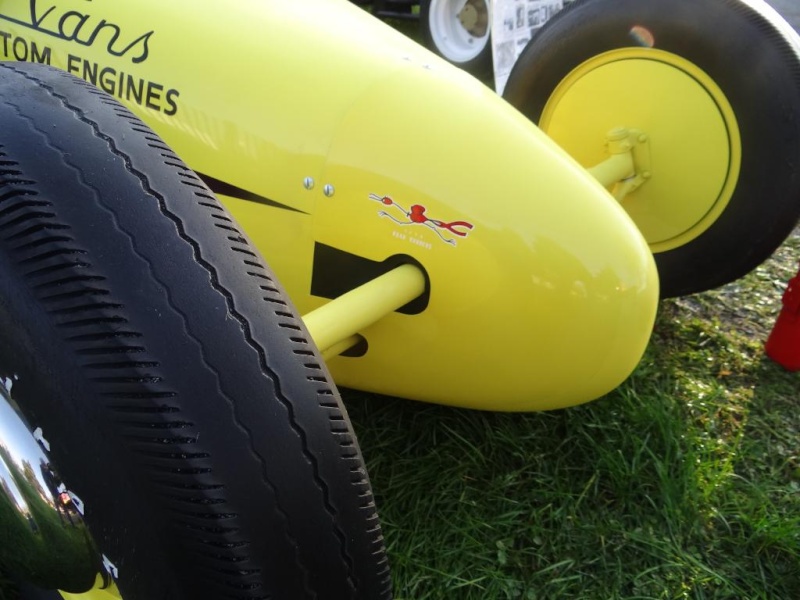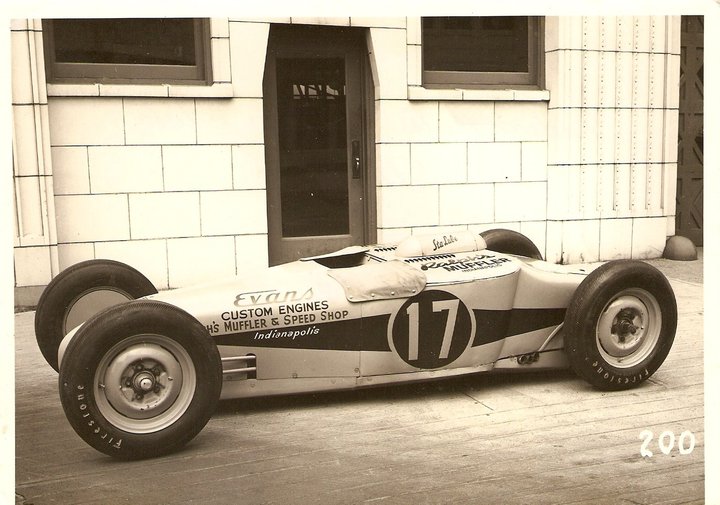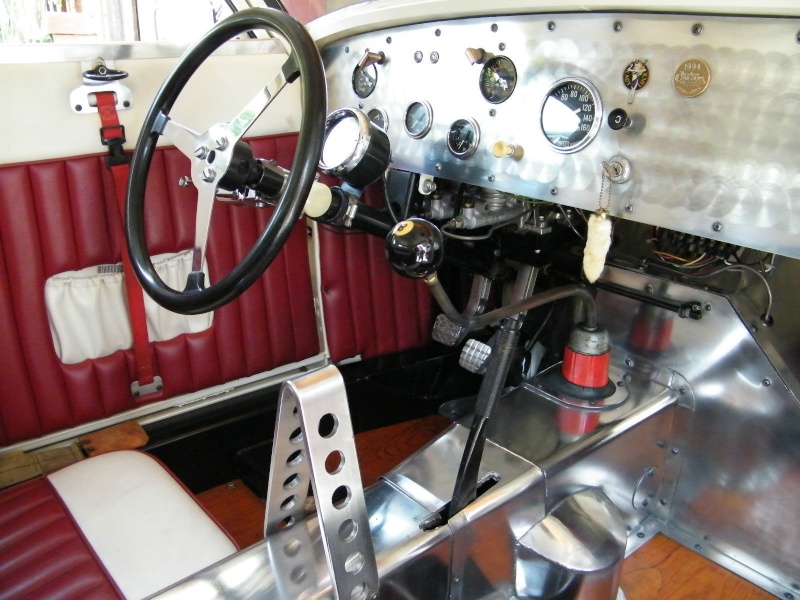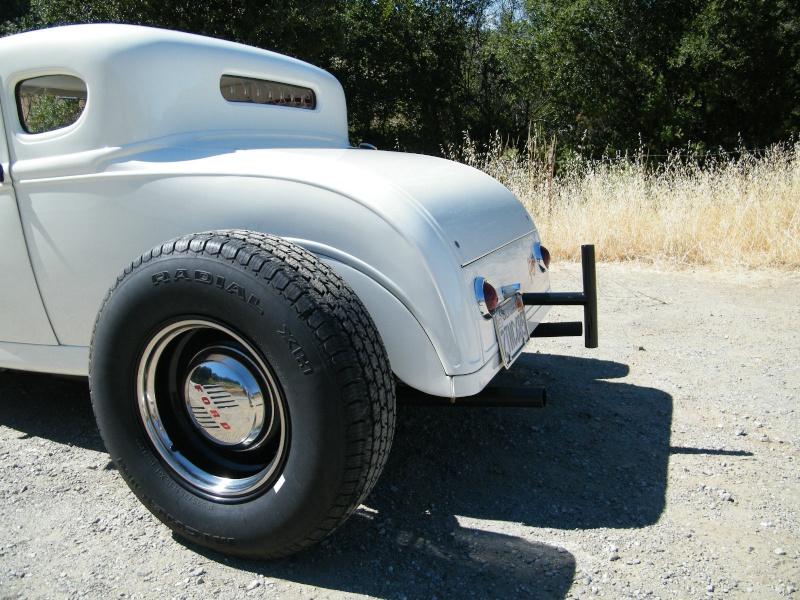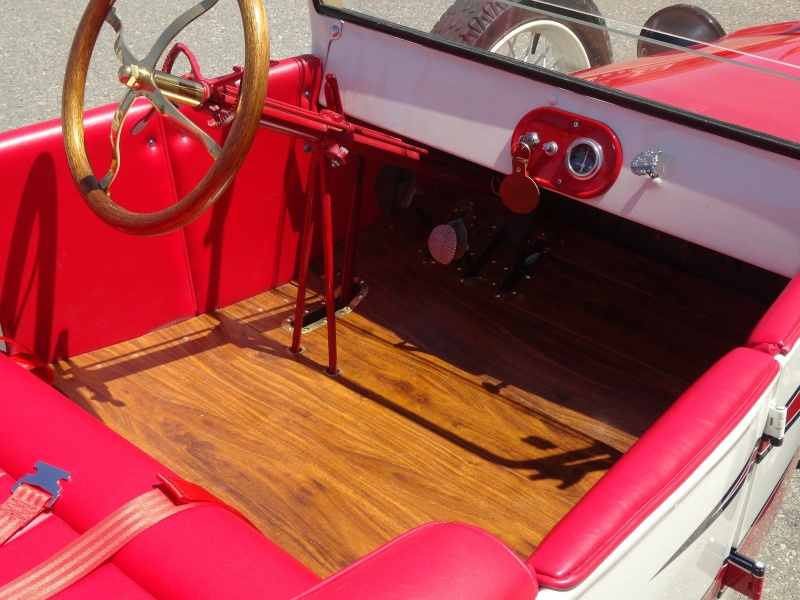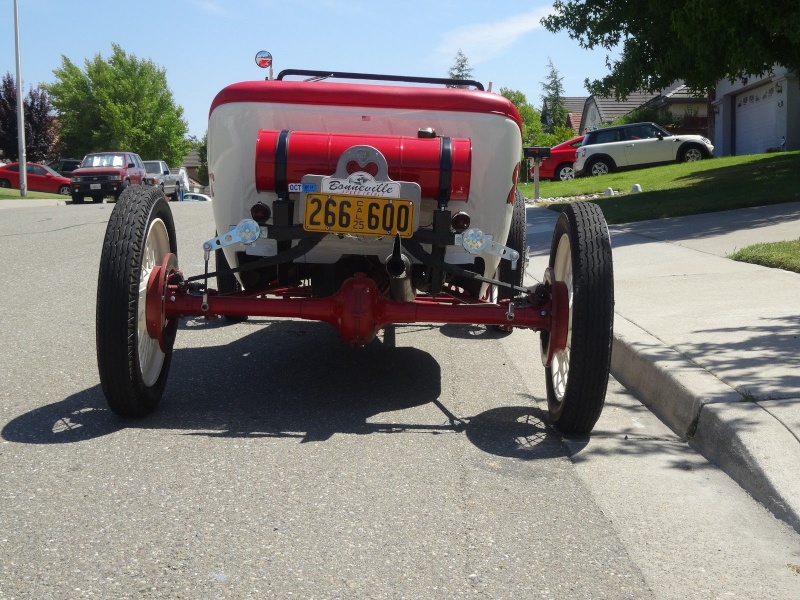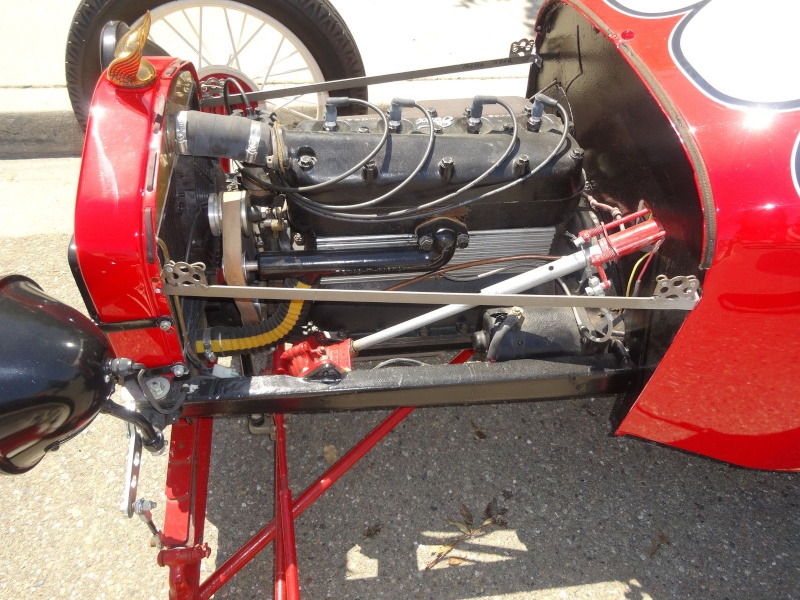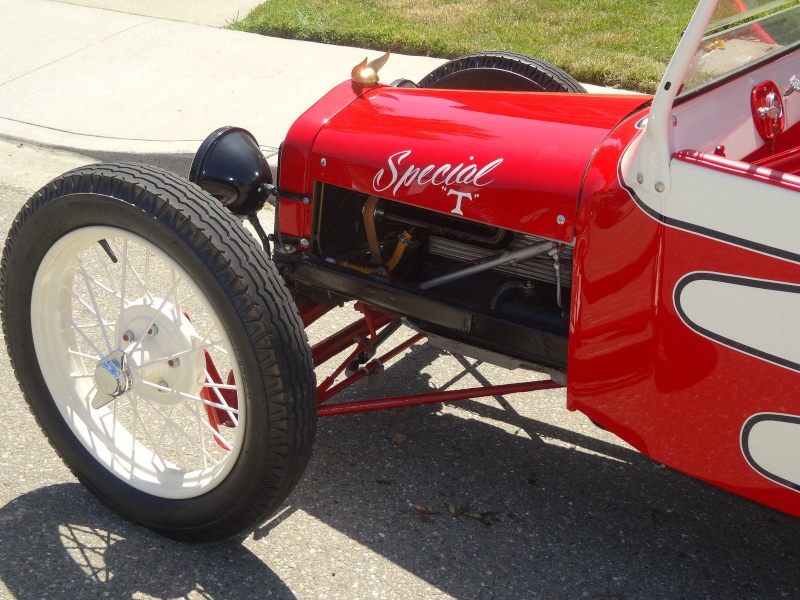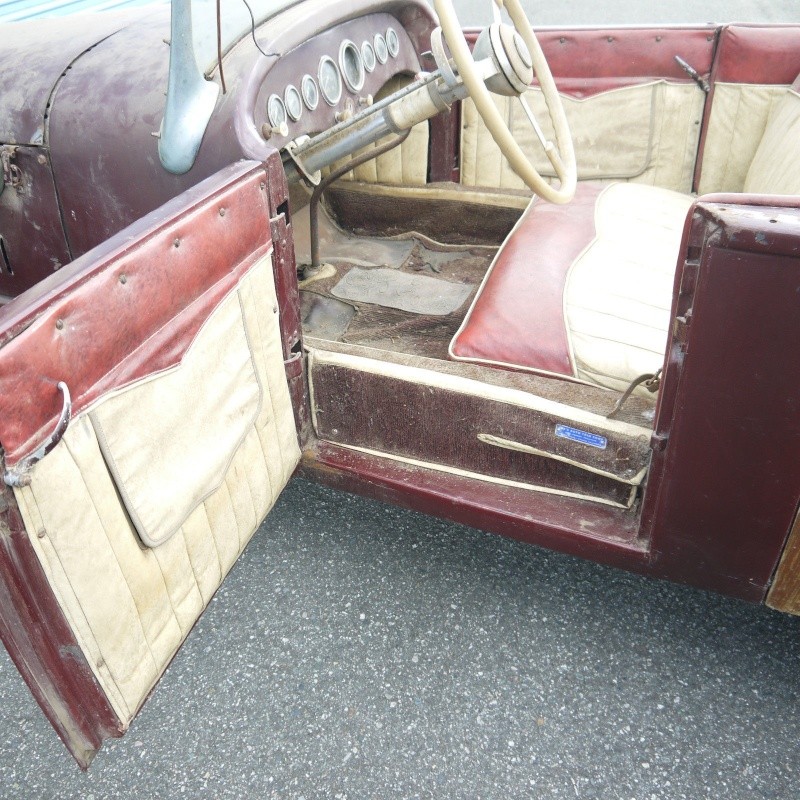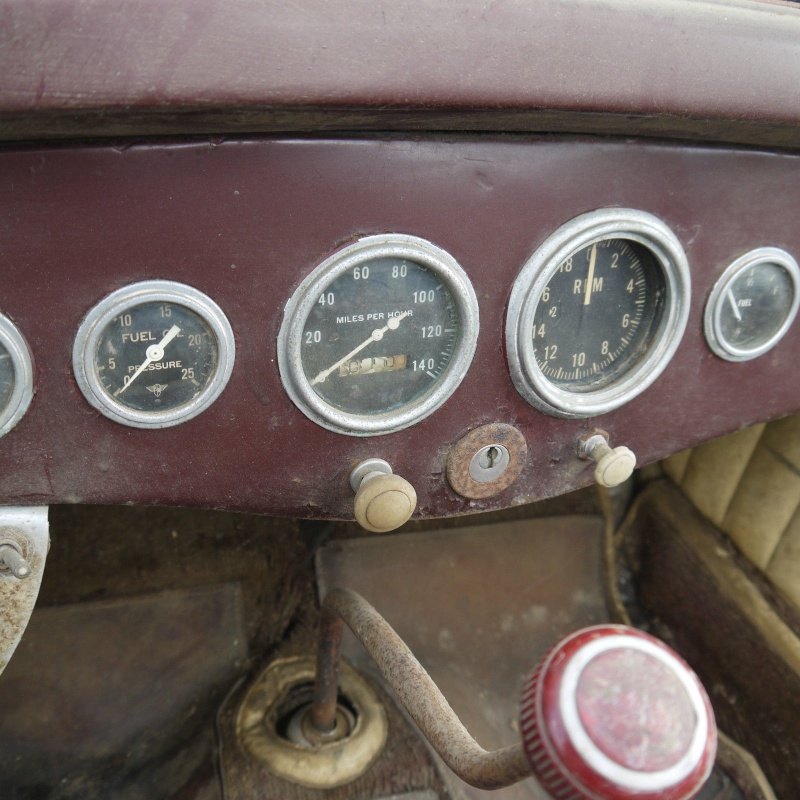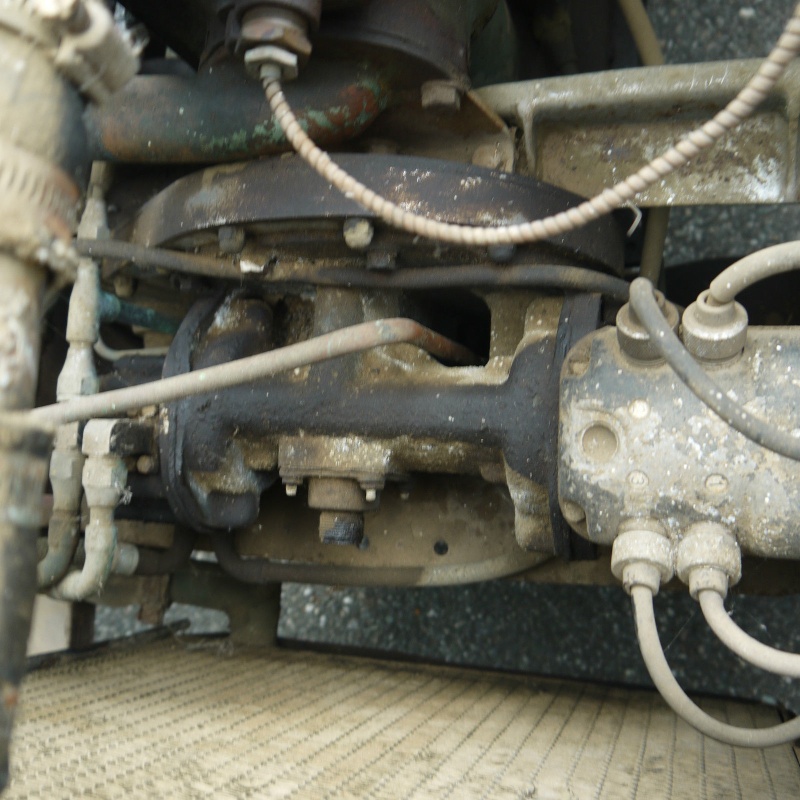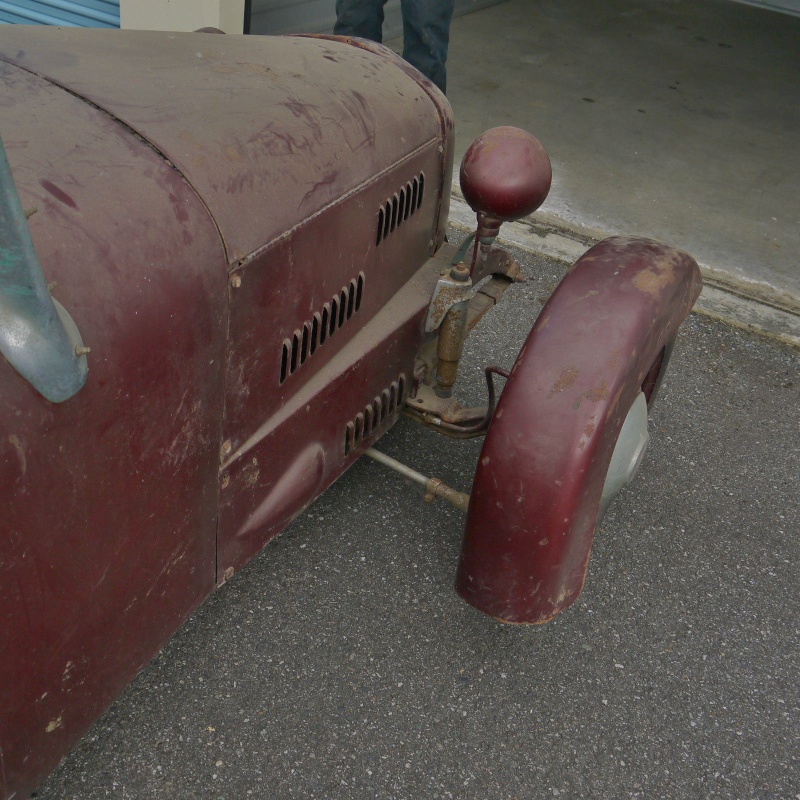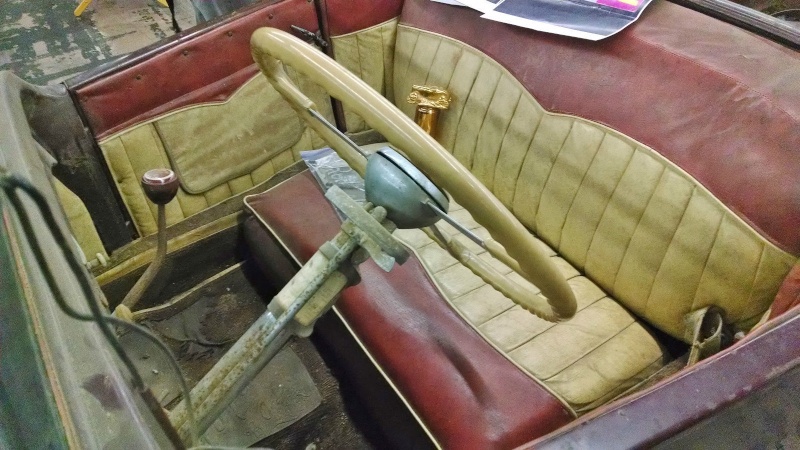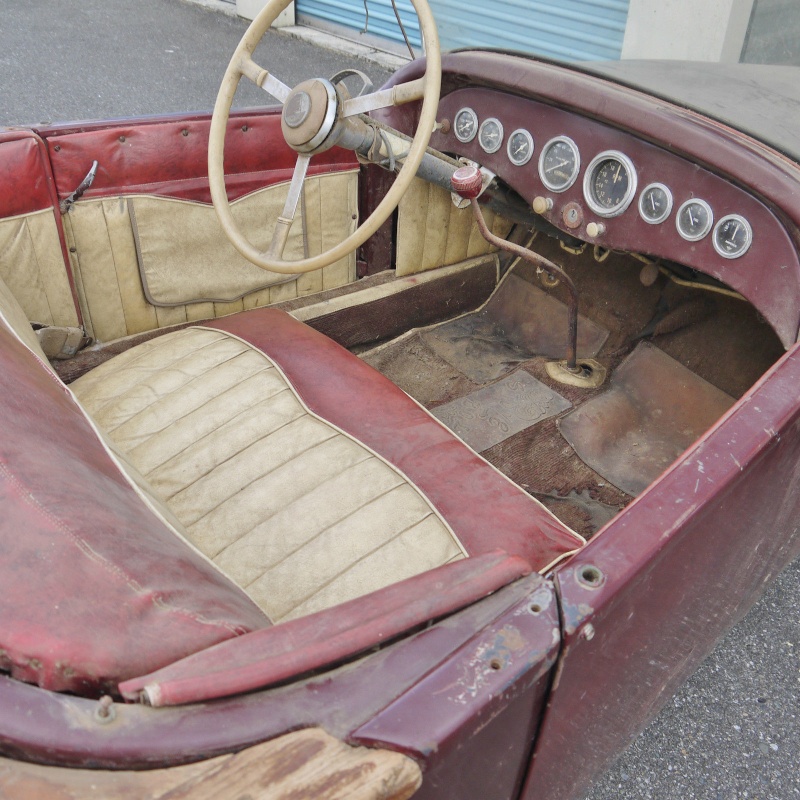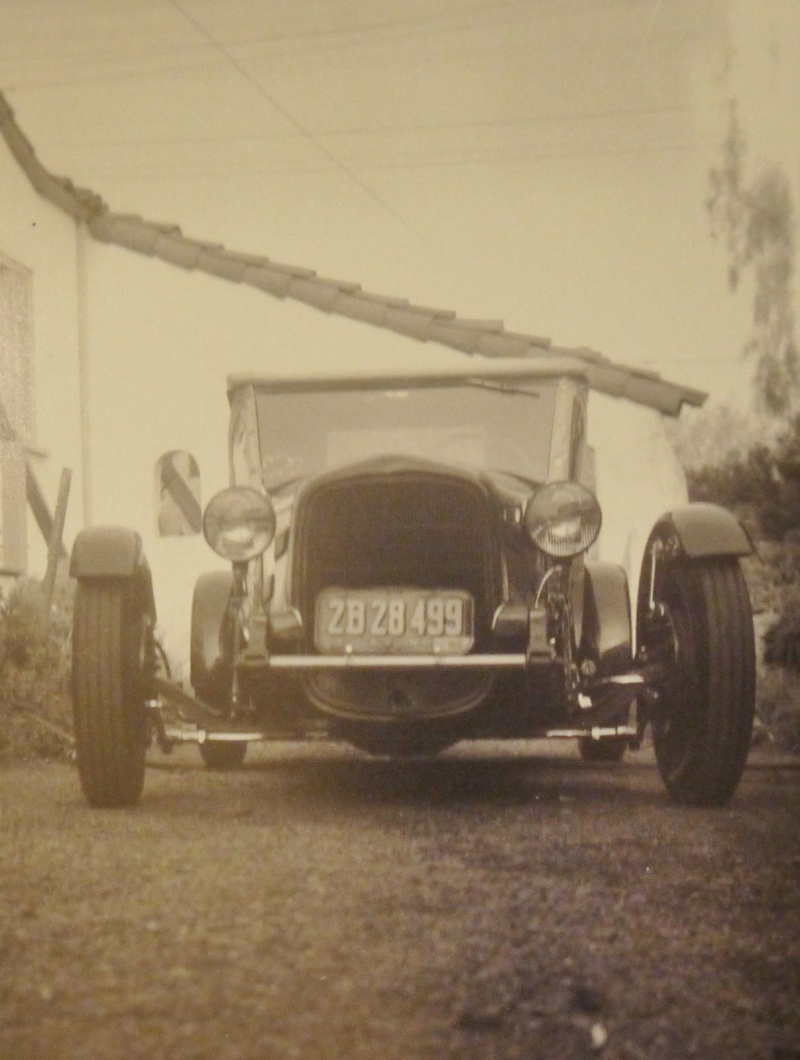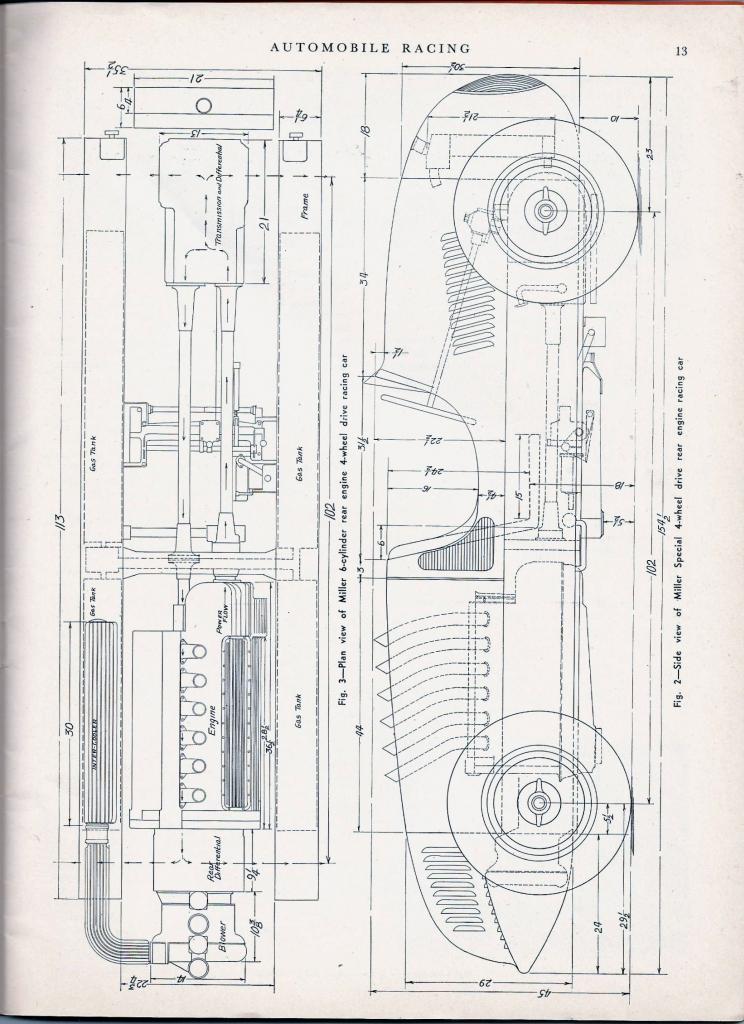Hot rod racer
+3
Metalshop16
ChevyDave
Predicta
7 participants
Page 3 sur 6 •  1, 2, 3, 4, 5, 6
1, 2, 3, 4, 5, 6 
 1929 FORD MODEL "A" RACER
1929 FORD MODEL "A" RACER

THIS CAR IS ALWAYS GARAGED, IS TURN KEY, HAND BUILT, METAL BODY, AND READY TO GO DRIVING OR RACING AS IT IS A 1929 MODEL "A" BOAT-TAIL RACER, NOT RUSTED OUT. THIS CAR IS A LOW MILEAGE CAR THAT I CHANGED OVER FROM A 6 VOLT SYSTEM TO A 12 VOLT SYSTEM. THE ENGINE IS A REBUILT, BALANCED 4 CYL WITH A REALLY NICE 3 SPEED MOUNTED ON THE FLOO

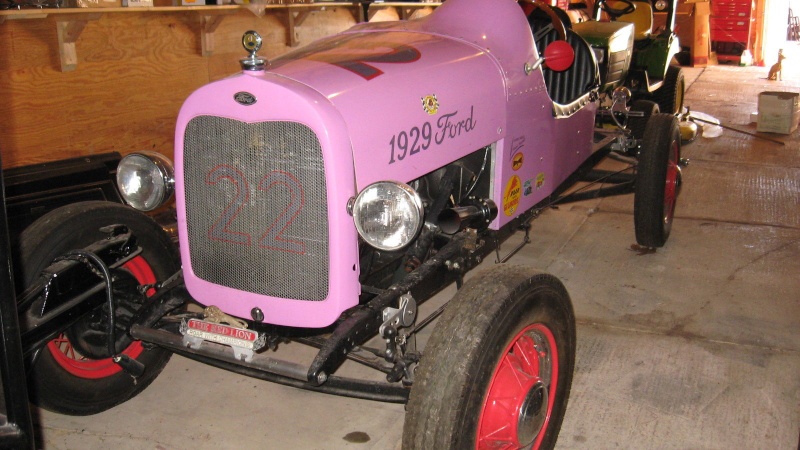
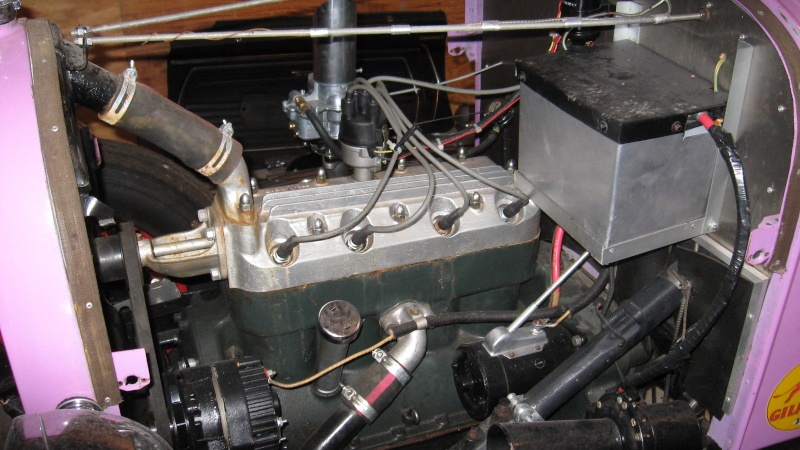



_________________
We don't care the People Says , Rock 'n' roll is here to stay - Danny & the Juniors - 1958
 1930 Model A coupe hot rod
1930 Model A coupe hot rod

Ever dream of owning and driving a traditional street rod that does wheelies and runs 9's in the qtr? I did too so I built one very special hot rod. I built this rod about 20 years ago to "replace" my first hot rod. I drove it on the street with a 409, 4 speed for most of that time. I started drag racing it seriously and decided to go faster and preserve the rare 409 engine, which I dropped in a strait axle '57 post gasser with 6 Stromberg 97's, 4 speed. I scored the NASCAR SB2.2 engine Dale Jr. ran at Michigan in 2003 (He won!) from an engine builder at DEI back when Sr. was still alive. Damn, I miss Dale!! I had to beef the entire drivetrain so I went to a Lenco 4 speed, Crower multi disk pro-mod clutch and Mark Williams Modular 9" rear with 6.20 gears on a light weight spool and 35 spline MW alloy axles. The car turns the 1/4 in the 9's on race gas at our 5000' altitude here in Albuquerque. It has never been dyno tuned and I'm sure there is way more in it, especially if you run Alcohol!!. I "souped it up" from the NASCAR specifications which dictate 12-1 compression, 750 CFM carbs and flat tappet cams. The carb is now a 1250 Dominator that Barry Grant flowed out to 1380. He even initialed the carb with a vibrator tool. (see pic) The cam is a new Custom ground Comp Cam roller that has .988 LIFT!! Rockers are shaft mounter Jesel 1.75-1 ratio. I went to 14 1/2-1 compression with custom JE forged pistons anticipating on going to Alcohol but it runs just fine on 112 race gas.
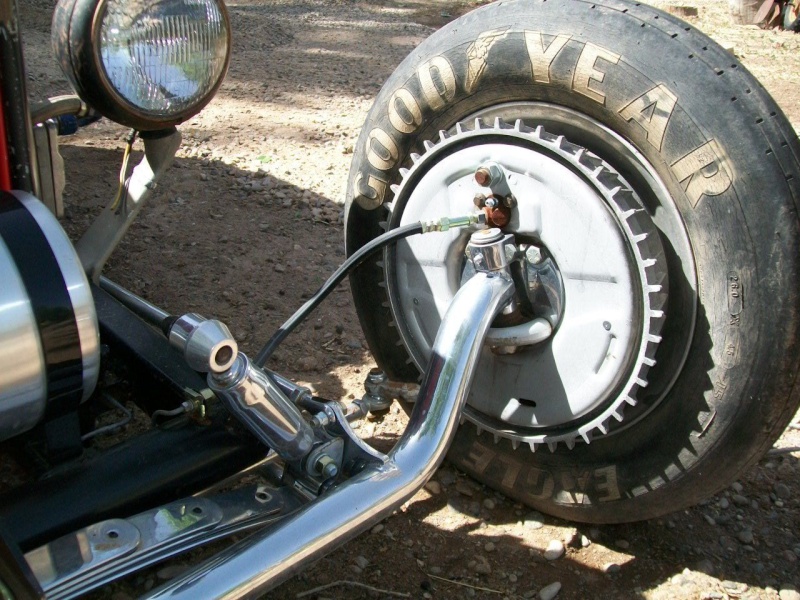
It has a '46 Ford dash with original gauges that have "modern guts" from SW. I glued the original needles on the SW gauges and used the original gauge faces. The speedo is replaced with a memory, shift light Auto-Meter tach. The engine loves 9800 rpm. all day long. The clutch is a Tilton Hydraulic with an "internal" throwout bearing. No linkage outside the scatter shield. The clutch is a 10" Crower 3 disk Pro Mod sintered metal clutch that will last for ever against only 850 HP compared to the 2500 hp they are designed to harness. It's fully adjustable by removing a floor panel and a plate on the scatter shield. ,The trans is a Lenco 4 speed and you can add a "few" gears if you like just by bolting additional gears on. The ratios are 1.44 1st, 1.38 for 2nd and 1.31 for 3rd with 1-1 for 4th. Combining the ratio's gives 4.13 1st, 2.69 2nd, 1.31 3rd and 1-1 4th. 60' times are 1.1 seconds so brace your neck! The aluminum modular Mark Williams rear has coilovers and an adjustable 4 link. The center section is a MW Nodular steel unit. 35 spline MW alloy axles with a WM lightweight spool. 6.20 NASCAR gears!! I'd recommend 5.90's and have a "lightly used" set of polished and hardened NASCAR set I'll include.

It has a 6" tubular chrome front axle with '56 Ford PU hubs drilled for 4 3/4" bolt pattern. The backing plates are '41 Lincoln repro from Speedway with 2" x 2 1/4" "self energising" shoes and '58 Buick finned aluminum drums. The front wheels are Weld Super Lites 15" x 4" with front runners that have plenty of tred but suffer dry rot from out 5% "humidity". The rears are Weld wheels also super lights, 15" x 12" with 31" x 13.5" Hooser slicks. They only have 6 runs on them and are fresh and not dry rotted.

It comes with a clear title and all the "required safety stuff" so you can drive it on the street!!! Wheelies at the stop lights!! The NASCAR engine is amazingly streetable and runs cool with the 4 core aluminum radiator it has. I included a thermostatically controlled cooling fan. It has an alternator to keep things going. It runs a NASCAR MSD ignition distributor and coil. It has a line lock and launch control built into the clutch pedal. With the cllutch all the way to the floor, it energizes two switch's. One for the line lock so the car doesn't roll at the line and the other switch energizes the 3 way RPM module for a launch RPM limiter just like pro stocks!. Instead of a chip for launch RPM, I use MSD's selectable RPM module allowing launch RPM from 6000 to 8500 with the turn of a dial. Stage at the line, mash the throttle and launch at a predictable RPM every time. I use a toggle switch to energize the line lock during burn outs as you need to pull different levers to shift up during the burn out. The switch is a double pole to turn on the "burn out" chip in the RPM limiter module so when you do burn outs, just mash the throttle and the chip limits the RPM for you. The RPM module is a three way. One for burn outs, one for launch RPM and the other is the normal RPM limiter to keep from blowing the engine during a run.

In addition to the "pedigree" of Dale Jr's engine, (as if that wasn't enough) the car has been in HOT ROD MAG, CK DELUXE, OL'SKOOL RODZ and HOT ROD DELUXE. The reason it was in CK DELUXE and OL'SKOOL RODZ is because I'm OTTO MECHANIC and write tech articles for them. Is that cheating? It also won the "FASTEST" trophy at the 2010 Hot Rod Rumble in Albuquerque and was voted "The most fun car to watch" by the fans at the same event. The rod also appeared on HOT ROD MAG TV in 2010 and also on their "Best of 2010" show. I had the 409 in it then. I was the guy that recommended you TASTE YOUR OIL to check the condition. I got calls from all over the country asking if it was really oil during the demonstration. It was chocolate syrup!

_________________
We don't care the People Says , Rock 'n' roll is here to stay - Danny & the Juniors - 1958
 Re: Hot rod racer
Re: Hot rod racer

Truth in sales; At the 2011 HOT ROD RUMBLE event, I lost it when I pulled 2nd and crashed like a big dog. It started heading for the left wall and when I corrected, while keeping my foot in it,, it came around and across the track heading almost straight into the right wall. It hit hard and "bounced" off the wall and rotated 180 degrees and ended up in the middle of the right lane. Amazingly, I missed the other car, which was my '35 rat a friend was racing to "feel the effervesance" of drag racing, first in front of it and then behind it after bouncing off the wall!! I could have wiped out both of my rods!! God was smiling on me. The crash pic can be seen in HR DEluxe in the Sept 2010 issue, page 22. They have good taste! The rat pictured above my crash pic with the '49 Ford rear clip and SCHWING license plate is my daily driver and was the car in the other lane when I crashed! When I repaired the coupe, I cut everything in front of the firewall off and replaced it with 2" x 3" rectangle tubing. I stretched the frame 24" to bring the wheelbase to 125" while I was at it. It goes much, much straiter with the extra 24" wheelbase! I also ditched the entire front axle that was a "spring over" and went to suicide spring behind the axle. Chrome everything, 6" drop. I build all my rods on a "true table" so everything stays straight and level. Funny point, Todd Ryden from MSD ignitions authored the article and described the crash as "kissed the wall". I called him and said, "You didn't see the crash did you?" He said no and I said it was no 1st base kiss, it was a "home run out of the park!" The rods all better now! The first 2 pics show the "short version" of the rod but all the others show it after the 24" stretch and were taken yesterday. Much lower and longer than before. Compare pic 2 and 3 to see the change in "attitude". Shoot, it looks bad from any angle! Search, "Otto'sStuntRace.mov on you-tube to see it in action when I got oil under my rear tires and saved it 3 times from hitting the wall. I was cranking the wheel like a mo fo!! This was the year after I stuffed it and I didn't want to do it again. The oil came from my Oberg return line filter which had a dry screen O ring in it. A new one replaced it and fixed the leak. No damage to the engine as it was a return line. "otto'sstuntrace.mov"

What's the story on these NASCAR SB2.2 engines? Besides kicking out 850+ normally aspirated HP with 356 cubic inches, they are "normal" SBC blocks with some very special heads and intake. You can "convert" any SBC to a SB2.2 in function just by bolting the SB2.2 heads on. Keeping the bottom end alive is the problem with "stock 4 bolt blocks". The SB2.2 blocks have billet. splayed 4bolt main caps, 30 MM roller bearings for the cam and angled lifter bores. They are all designed for dry sump oiling. They don't have an oil filter boss.

ENGINE BUILD SPEC'S; ( If your not an engine builder, ask one if this engine was assembled right. If they say "NO", have them call me!
4.156 bore, JE custom forged pistons
crank, billet Bryant 3.285 stroke
6.200 Carrillo "H" beam rods torqued to 60# w/ARP bolts
Pistons - deck top, .004 down in the hole
Felpro 1034 Head gaskets
1.75 ratio rockers, Jesel shaft mount torque mounting bolts to 26# and adjusters to 12#
Jesel adjustable timing belt, new
14.5-1 compression ratio
Cam is a custom grind Comp Cams solid roller w/275/280 duration at .050, .436 lobe 114 sep and in the engine at 106 ILC. Lift .988 at the valve, yes .988!!
Lash is .020 hot I @ E or .010 cold set at TDC
Intake valves, 2.18" Titanium, 6MM stems
Exhaust valves, 1.68", Titanium, 6mm stems.
Titanium valve spring retainers
Valve springs ISKY 9985, spring test 235-240# on the seat
Timing at sea level, 31-33 BTDC
MSD NASCAR ignition
Bore clearance is .008
Main and rods clearance, .0023
Side clearance rods, .018
Pin in piston, .0013
Pin in rod, ,0018
Cam thrust clearance, .004 with silicone, no paper gasket.
Silicone for pan gasket, no cork or paper.
Oil pressure adjustment, 80 PSI above 5000 RPM
Oil pressure at idle hot, 30# @ 1800 RPM
Synthetic oil only! Mobile 1, Redline, Purple, etc. 5W-30 NEVER COLD START THE ENGINE WITHOUT PLUGGING IN THE OIL TANK HEATERS AND REACHING AT LEAST 180 DEGREES.
Normal leakdown is 3-6% COLD
Crankcase vacuum 13-16#
Oil pump, 4 stage dry sump, belt drive, 8 gallon tank in the rear
Oil filters, 3, 1 coming out of the engine, an Oberg to check after every run. 1 Peterson in the rear coming out of the dry sump tank and 1 Peterson between the dry sump pump and the engine in line. All can be disassembled for inspection.
Dry sump oil tank, Rear mounted for traction, 8 Gallon w/2 110V "strap" heaters and a dip stick.
Exhaust headers, Stainless steel NASCAR progressive diameter, tri-Y design, adjustable for length. Loud, fast and very trick!!

The engine has a "PRE-OILER" to fill the complete engine oil passages before firing it up. Pressurizes to 30# and shuts off automatically. USE EVERY TIME YOU FIRE IT to eliminate "dry starts".
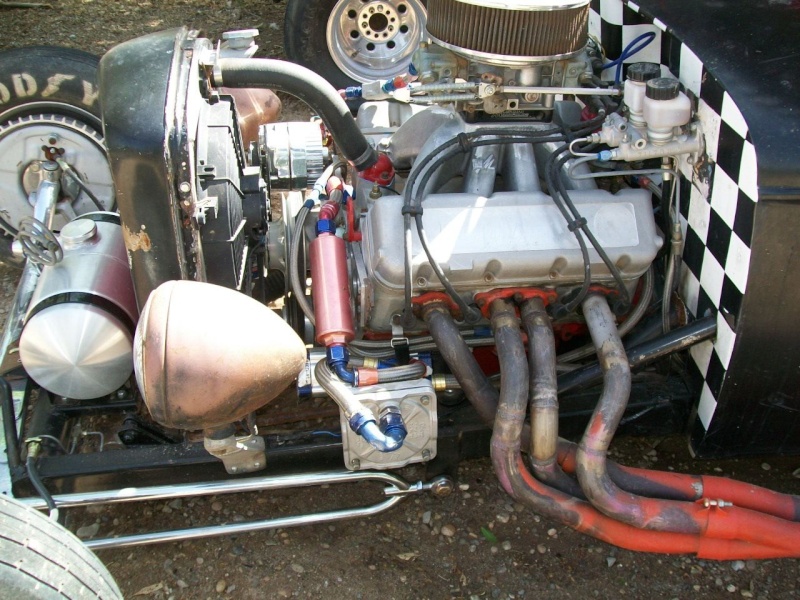
I planned on running the nostalgia races with it and hope who ever the lucky dog is that wins the auction takes it out and blows everybody's doors off. I used to put down a Muncie Rock Crusher 4 speed on the drag race tech sheet so everybody thought I was "Mr 4 Speed" and never missed a gear! lol

_________________
We don't care the People Says , Rock 'n' roll is here to stay - Danny & the Juniors - 1958
 Re: Hot rod racer
Re: Hot rod racer
_________________
We don't care the People Says , Rock 'n' roll is here to stay - Danny & the Juniors - 1958
 1927 "Spade Carrillo" Roadster Bonneville History
1927 "Spade Carrillo" Roadster Bonneville History

1927 "Spade Carrillo" Roadster
Bonneville History

The very famous and well documented " Spade Carrillo" 1927 T Roadster is For Sale. Built in late 1950, to be ran at the Bonneville Salts Flats in 1951, this mid-engine roadster was clocked at a one-way speed of 178.162 mph. Soon after, it was the Hot Rod magazine cover car in July, 1952 and the rest is Hot-Rod History. Many articles have been written about the extraordinary car over the years, but the link below, to the Hot Rod magazine article by Thom Taylor is one of the best. Take a look.
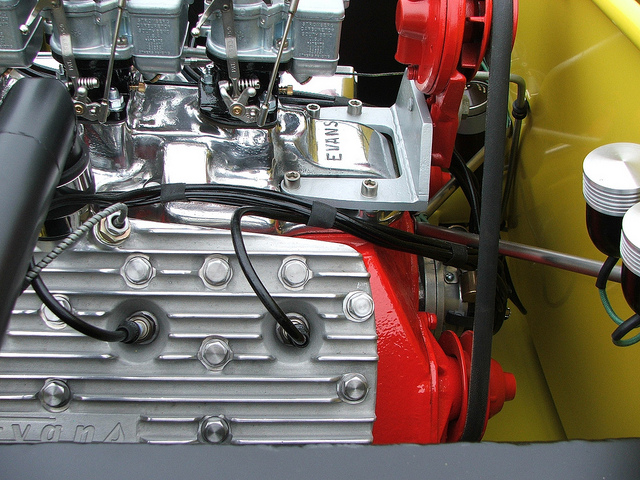
http://www.hotrod.com/featuredvehicles/1309_fred_carrillos_reborn_roadster/
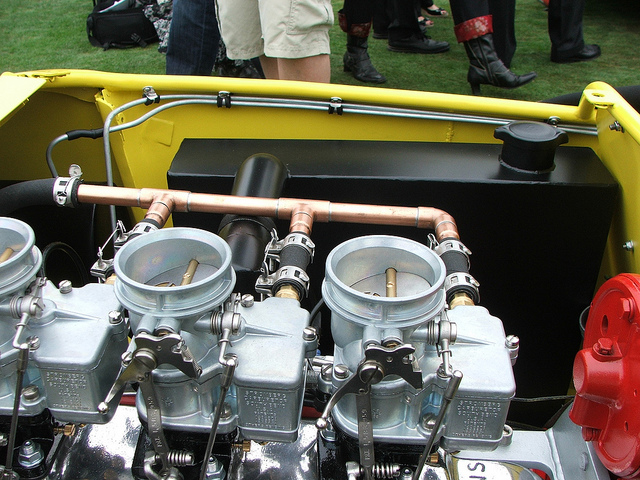
In recent years, the car was restored by the current owner, Frank Morawski of Bel Air, Md. and many of his friends. The Carrillo Roadster was one of only nine cars selected for the "Land Speed" group at the Peeble Beach Concours d'Elegance in 2010. It was selected again by Hot Rod magazine for the cover car display at the Amelia Island Concours d'Elegance, Cover Car for the # 50 issue of Rodders Journal magazine with 16 pages of coverage, AACA Junior and Senior awards at the Hershey AACA Fall meet and most recently in January, 2014 it was selected for the 65th Hot Rod magazine display in the "Century of Speed" show at the Grand National Roadster Show. The car is currently on display at the The Wally Parks NHRA Motorsports Museum in Pomona, Ca.
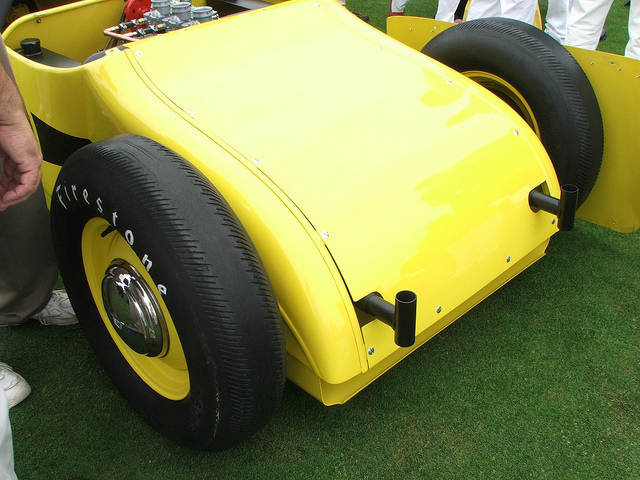
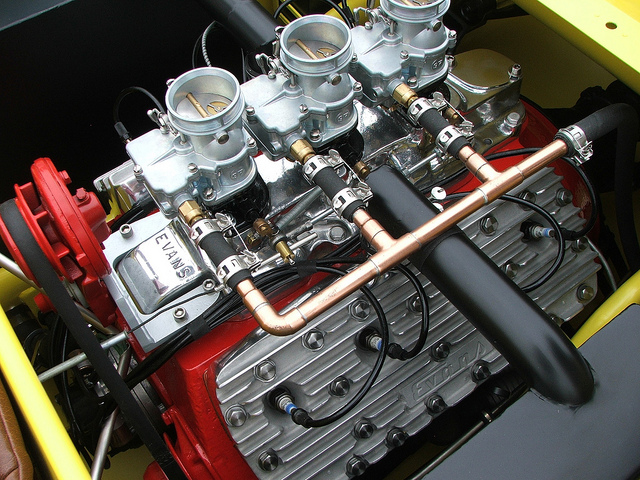
_________________
We don't care the People Says , Rock 'n' roll is here to stay - Danny & the Juniors - 1958
 Re: Hot rod racer
Re: Hot rod racer
_________________
We don't care the People Says , Rock 'n' roll is here to stay - Danny & the Juniors - 1958
 Re: Hot rod racer
Re: Hot rod racer
_________________
We don't care the People Says , Rock 'n' roll is here to stay - Danny & the Juniors - 1958
 Re: Hot rod racer
Re: Hot rod racer
_________________
We don't care the People Says , Rock 'n' roll is here to stay - Danny & the Juniors - 1958
 Re: Hot rod racer
Re: Hot rod racer
_________________
We don't care the People Says , Rock 'n' roll is here to stay - Danny & the Juniors - 1958
 1932 Ford Roadster Drag Race Car
1932 Ford Roadster Drag Race Car

Its a fiberglass body and reproduction boxed frame. The drive line is a sbc 355 ci, 489 HP motor, (dyno) with Comp cam, roller rockers, Brodix heads and intake, hyperetectic Federal Mogul 10 3/4 pistons, GM 5.7 rods, blueprinted, 750 Demon carb, vertex mag, Transmission is a TCI, manual powerglide, 3500 stall converter w/trans brake. The rear end is a full spool Johns 4:11 gears and Big ford disc brakes. The steering is Vega. The front axle is Genie, 40 Ford, with spindles, wishbone, tie rods and drag link by Speedway. Its true to a 50`s-60`s altered roadster.The motor is set back 20% and mounted solid as is the transmission and rear end. It has a "pull-off" steering wheel, Wildwood MC, and aluminum seat by Speedway. The roll cage is removable, with 8 grade bolts, and takes about 30 minutes to covert to the NHRA cage. There is a tonneau cover for both cages. This vehicle (and my tow car) were featured in Rodders Journal #57, in 2012. It has a nut and bolt description and beautiful pictures by Steve Coonan. The car runs in the high 10`s, at 125 MPH. It could run faster but NHRA rule changes make it easier to race above 10 seconds. The car is very dependable, exciting and fun. You may have seen it at Indy, Goodguys, Hamb Drags, Bowling Green or around Florida (including Billetproof). The car is a crowd sensation wherever it displays or races. It also won an award at the Detroit Autorama. The vehicle comes with a new Bell helmet and custom trailer (see pictures) I will not separate the car and trailer. I took the car to the Rodders Journal annual event towed by my 36 Ford and the looks I got along #95 were awesome. The color is GM Hugger Oraange. It has a large radiator (in trunk), Optima battery, extra M/T slicks and slotted mags for the rear,

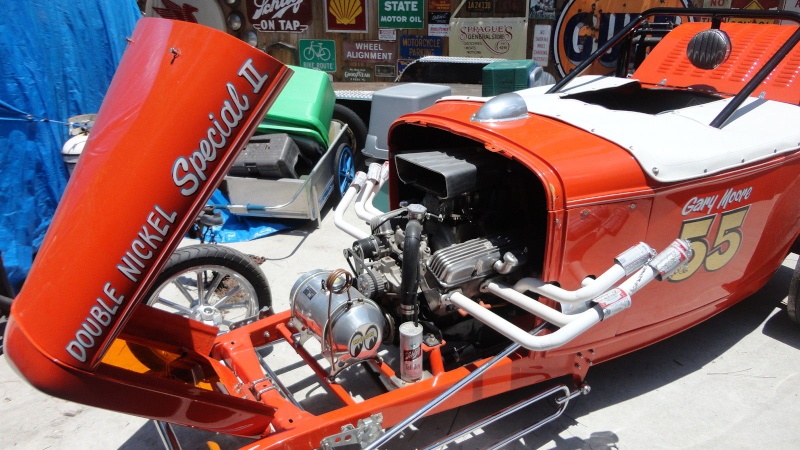
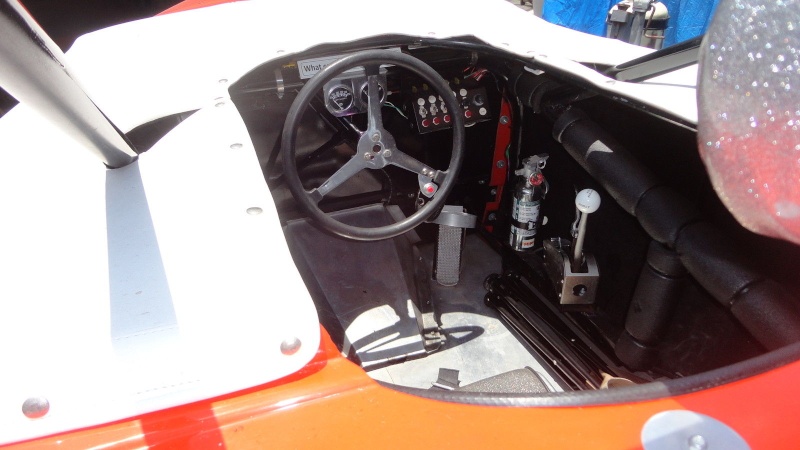

_________________
We don't care the People Says , Rock 'n' roll is here to stay - Danny & the Juniors - 1958
 Re: Hot rod racer
Re: Hot rod racer
When you’re at Bonneville you see all sorts of crazy contraptions while walking (and driving) around the five mile long pit and spectator area. You witness things that can rocket to speeds just shy of 400 miles per hour to things that are created to look the best while flossing at 20 miles per hour. Basically, you see the whole spectrum from pure performance to pure hardparking. It’s phenomenal to be able to to be able to take all of this at a single event.

With such an eclectic mix of cars, you also meet an eclectic mix of people. The owner of this rat rod is one of those crazy individuals that travelled long distances to attend the cultural festival at the Salt. He drove his RV with the car trailer from Vancouver, Canada to the Utah. He is 100% devoted to hot rod culture. And the build quality of this ‘rat rod’ even questions if we should even categorize it as that. Rod and I met and conversed with this fellow, Ken (from Top 10 Hot Rod & Customs) before we even saw the car. When he mentioned something to the nature of, “hey do you want to see my car?” The response came out instantly: “Yes Ken, we DO want to see whatever you have!”
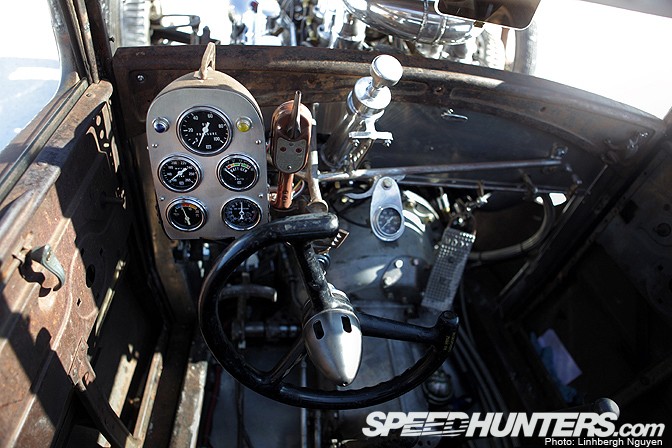
We had absolutely no clue what to expect when we walked to the car trailer and those doors opened…

What laid before us was a 1930 Ford coupe rat rod. A car that barely even held onto the idea that it is, indeed, a rat rod. But what this car did have was an absolutely menacing presence and that each and every nut, bolt, and piece of metal on the car seemed like it radiated with history. And as we talked to Ken a bit more, we soon found out that assumption was true. Every part on this car has a vintage going to the late 50s.
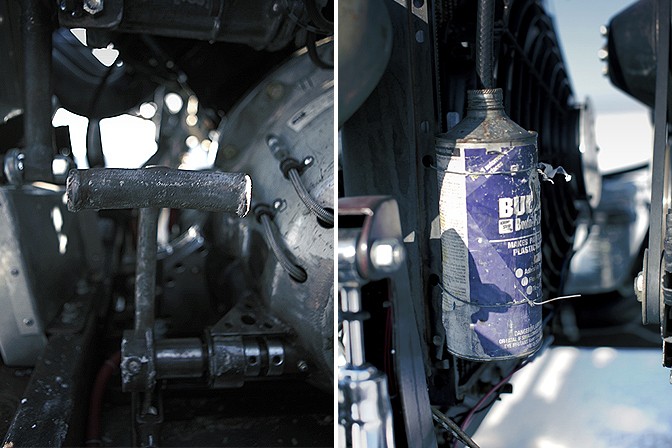
As I stepped into the cockpit of the Ford Coupe, what followed was an eye opening experience filled with ‘ooohs’ and ‘ahhhs’. There was not a single creature comfort to be found on the inside. Everything was bare metal, with the exception of the seat cushions. There are some parts on the inside of the car where you can see straight out onto the ground. And when you take a hold of that steering wheel, you feel like you’ve been transported into the future, according to the 1950s, of course! And said steering wheel? That’s taken from Boeing B-29 bomber.

There’s a sense of elegance when every working part of the car is exposed. It’s almost like the modern art museum in Paris, the Centre Pompidou, where the inner workings of the building is exposed to the outside –the air ducts, piping, electrical, etc. The same aesthetic concept goes for this car. Every bit of the car that helps the car move and function is there to accentuate the style, flare, and aesthetic appeal to this car. It’s raw, and it’s real.

The metal rods surrounding the drive shaft is an area in the interior of the car that is of great beauty and is definitely something to marvel at.
_________________
We don't care the People Says , Rock 'n' roll is here to stay - Danny & the Juniors - 1958
 Re: Hot rod racer
Re: Hot rod racer
The exposed linkages from a four speed, aluminum cased transmission.
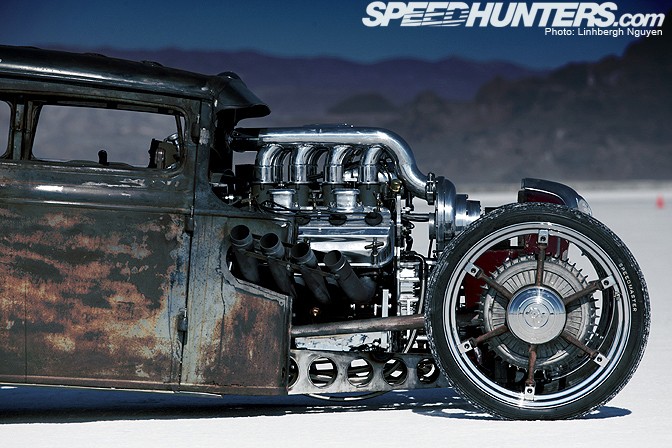
A dial for the water temperature which is just mounted on a rod that connects the ‘dashboard’ to the body of the car.
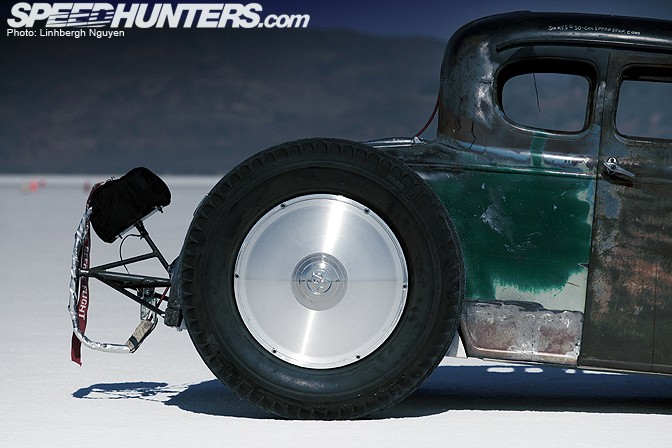
Exposed bits of metal and dials that harken back to simpler times –times when there was an engine, four wheels, and thats it. No reverse cameras, TVs, or electronic governing. The gauge pods themselves is actually a South Winds gas meter –not even a car part!

These switches seem like they were taken straight out of Flash Gordon’s spaceship.
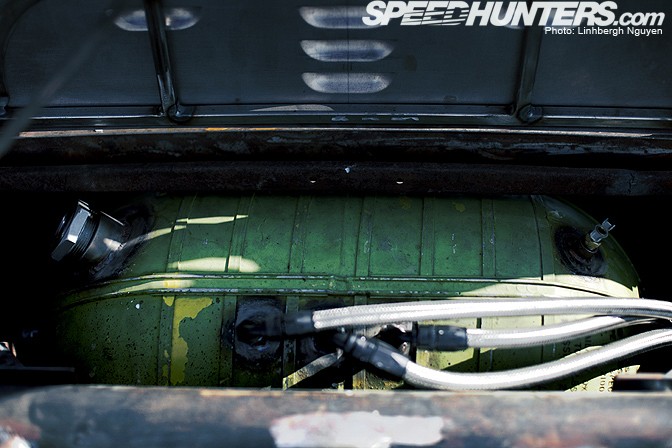
This car has twos pedals, one for the clutch and one the one that is the most important –the go button! And so I bet you’re wondering how does this thing stop? It stops with a hand operated rear brakes! This car is absolutely bonkers through and through!
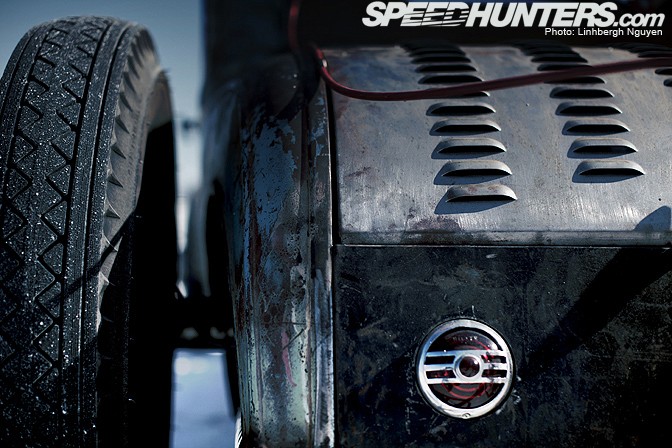
Even the sticker is vintage!

Six inches were chopped off the top of the original 1930 Ford coupe to give it a much more mean looking stance. The car’s name, Littleboy is an ode to the bomb that was dropped onto Hiroshima in 1945. Think what you may about that symbolism and it’s significance in world history. But the name suits the car quite well.

A dial for the water temperature which is just mounted on a rod that connects the ‘dashboard’ to the body of the car.

Exposed bits of metal and dials that harken back to simpler times –times when there was an engine, four wheels, and thats it. No reverse cameras, TVs, or electronic governing. The gauge pods themselves is actually a South Winds gas meter –not even a car part!

These switches seem like they were taken straight out of Flash Gordon’s spaceship.

This car has twos pedals, one for the clutch and one the one that is the most important –the go button! And so I bet you’re wondering how does this thing stop? It stops with a hand operated rear brakes! This car is absolutely bonkers through and through!

Even the sticker is vintage!

Six inches were chopped off the top of the original 1930 Ford coupe to give it a much more mean looking stance. The car’s name, Littleboy is an ode to the bomb that was dropped onto Hiroshima in 1945. Think what you may about that symbolism and it’s significance in world history. But the name suits the car quite well.
_________________
We don't care the People Says , Rock 'n' roll is here to stay - Danny & the Juniors - 1958
 Re: Hot rod racer
Re: Hot rod racer
The lettering of “Littleboy” was hand painted onto the door.
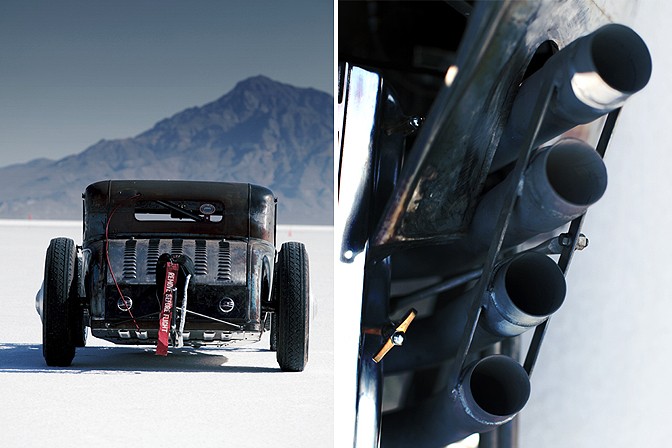
The bare metal also flows all the way out to the exterior of the car. You can see the layers of paint that some of the panels have. It really brings that sense that this car really has so much history. The rear tail light is from a 1939 Chrysler DeSoto. The chrome really stands out from the gritty bare metal and balances out the rear of the car quite well.
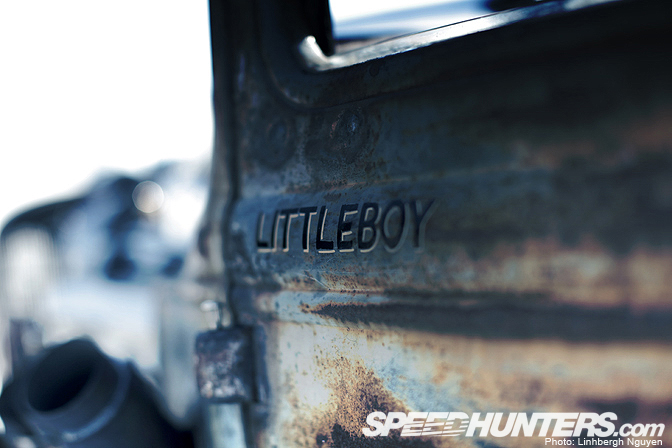
There may be a radiator grill in the front, which is from a 1947 Cockshut Tractor, but it definitely does not house the radiator. Follow the coolant lines all the way back into the trunk and you will find the only modern piece on this whole car. An aluminum radiator and an electric fan!

This fuel tank is also another part that has been converted from an airplane. It’s the oxygen tank, from a Boeing B-52, for the pilots when they were in high altitudes!

Like I said before, just about everything on this car is vintage up to the 1950s. The rear wheels from a 1940s Ford tractor and even the parachute is a vintage piece!
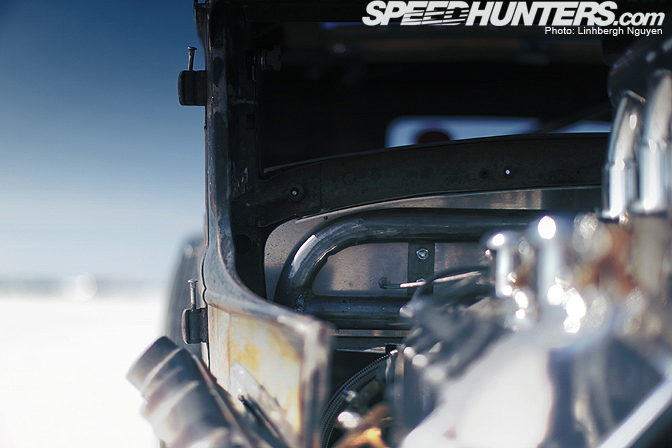
At the time that these photos were taken, the suspension were just a solid mount. The owner was actually thinking of putting on modern coilovers for true performance, but decided to keep it period.
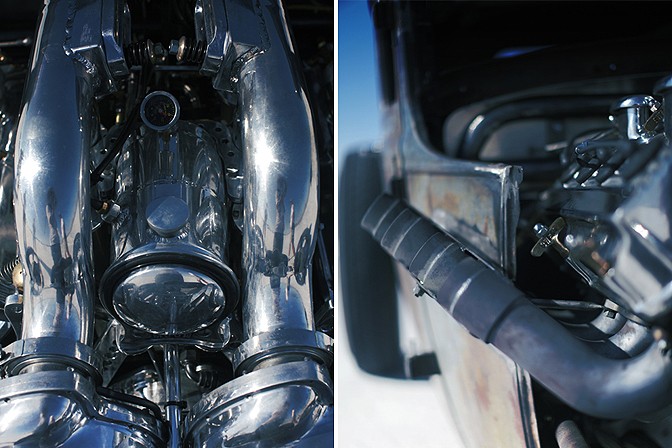

The bare metal also flows all the way out to the exterior of the car. You can see the layers of paint that some of the panels have. It really brings that sense that this car really has so much history. The rear tail light is from a 1939 Chrysler DeSoto. The chrome really stands out from the gritty bare metal and balances out the rear of the car quite well.

There may be a radiator grill in the front, which is from a 1947 Cockshut Tractor, but it definitely does not house the radiator. Follow the coolant lines all the way back into the trunk and you will find the only modern piece on this whole car. An aluminum radiator and an electric fan!

This fuel tank is also another part that has been converted from an airplane. It’s the oxygen tank, from a Boeing B-52, for the pilots when they were in high altitudes!

Like I said before, just about everything on this car is vintage up to the 1950s. The rear wheels from a 1940s Ford tractor and even the parachute is a vintage piece!

At the time that these photos were taken, the suspension were just a solid mount. The owner was actually thinking of putting on modern coilovers for true performance, but decided to keep it period.

_________________
We don't care the People Says , Rock 'n' roll is here to stay - Danny & the Juniors - 1958
 Re: Hot rod racer
Re: Hot rod racer
The bare metal also flows all the way out to the exterior of the car. You can see the layers of paint that some of the panels have. It really brings that sense that this car really has so much history. The rear tail light is from a 1939 Chrysler DeSoto. The chrome really stands out from the gritty bare metal and balances out the rear of the car quite well.
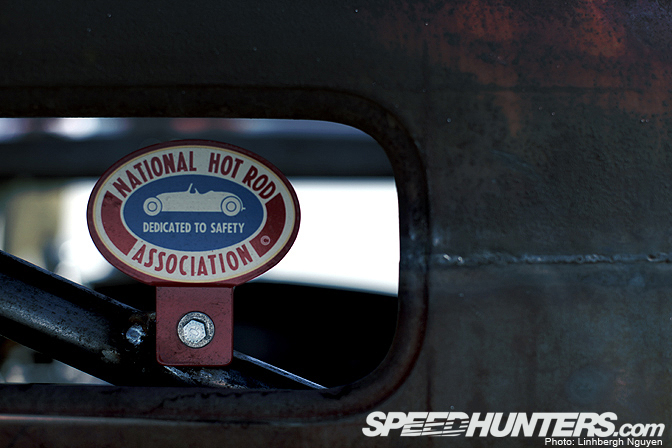
There may be a radiator grill in the front, which is from a 1947 Cockshut Tractor, but it definitely does not house the radiator. Follow the coolant lines all the way back into the trunk and you will find the only modern piece on this whole car. An aluminum radiator and an electric fan!
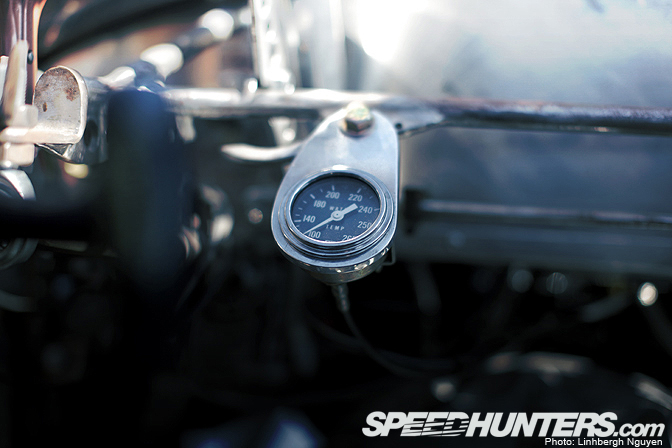
This fuel tank is also another part that has been converted from an airplane. It’s the oxygen tank, from a Boeing B-52, for the pilots when they were in high altitudes!
Like I said before, just about everything on this car is vintage up to the 1950s. The rear wheels from a 1940s Ford tractor and even the parachute is a vintage piece!
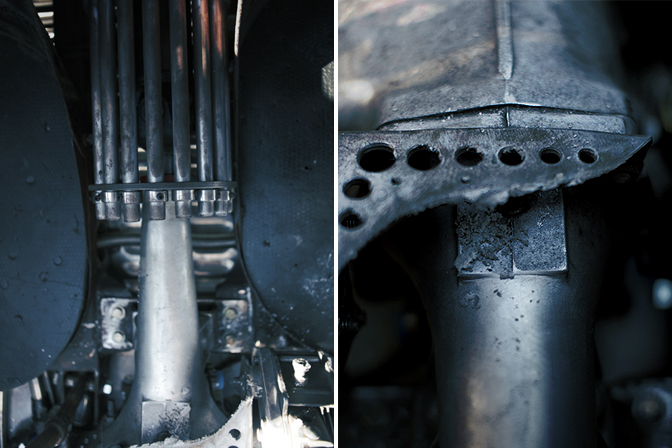
At the time that these photos were taken, the suspension were just a solid mount. The owner was actually thinking of putting on modern coilovers for true performance, but decided to keep it period.
The attention to detail and the quality of the build that this car has received can be seen by looking close to the frame and noticing that it follows the contours of the body. The chassis itself is completely hand made too with the exception of the ’30 Ford Coupe body on top of it. The front wheels are off of a International Harvester.
Now on to the meat of this car (or, should I say, the heart?), the motor. This extremely shiny, and elegant piece of metal is a 1957 Hemi V-8 which has been built for nitrous.
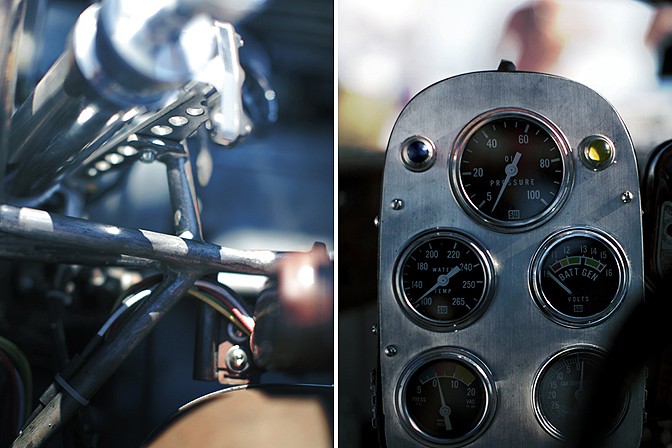
In the front of this massive engine sits two McCullough superchargers. When Ken took the car for a little jaunt around the pit area (let me remind you again that it is 5 miles long), you can hear these twin super charges whine from miles away. That sound, accompanied by the Hemi V-8 roaring out of its two collectors which exit both sides of the engine, is a sound that only mythical gods have the privilege of hearing to. Heavenly is an understatement.
Just looking at the engine is a sight to behold. If you liken this car to an art piece (which in my mind, it is), then the car is the painting, and the engine is Mona Lisa’s smile. It has that huge of an effect on the whole of the car.
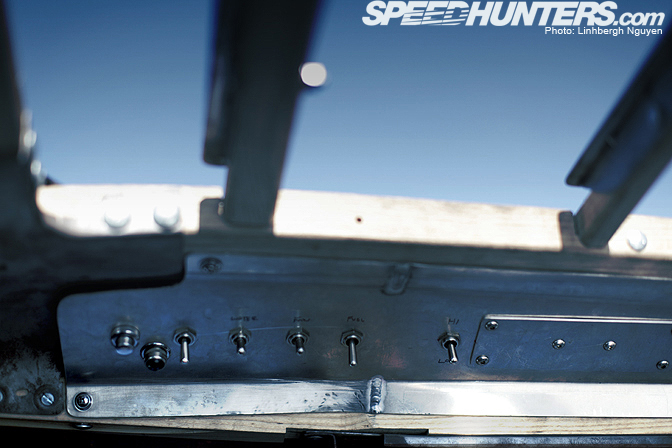
If you go to the Bonneville Speedweek with an open mind, you will meet tons and tons of people. And the thing is, they’re all extremely nice, gracious, and humble people. They are on the Salt for the sole reason to support and spread the knowledge, love, dedication to Hot Rod culture. They want everyone to see why it is such an old and prosperous scene. The owner of this car, Ken, is one of those people. And if anyone was to look at his car, they will instantly see that this car, even though it looks like a hunk of junk at first sight, is given the same bruised knuckle, finger burning, excessive yelling, lack of sleep treatment that pristine concours cars receive.
But you know what? I prefer this car to any extremely clean car. It has so much more character. For me, a car’s character is the deal breaker –and this car definitely has plenty of it.
-Linhbergh Nguyen
http://www.speedhunters.com/2009/08/car_feature_gt_gt_a_littleboy_s_rat_rod_dreamin/

There may be a radiator grill in the front, which is from a 1947 Cockshut Tractor, but it definitely does not house the radiator. Follow the coolant lines all the way back into the trunk and you will find the only modern piece on this whole car. An aluminum radiator and an electric fan!

This fuel tank is also another part that has been converted from an airplane. It’s the oxygen tank, from a Boeing B-52, for the pilots when they were in high altitudes!
Like I said before, just about everything on this car is vintage up to the 1950s. The rear wheels from a 1940s Ford tractor and even the parachute is a vintage piece!

At the time that these photos were taken, the suspension were just a solid mount. The owner was actually thinking of putting on modern coilovers for true performance, but decided to keep it period.
The attention to detail and the quality of the build that this car has received can be seen by looking close to the frame and noticing that it follows the contours of the body. The chassis itself is completely hand made too with the exception of the ’30 Ford Coupe body on top of it. The front wheels are off of a International Harvester.
Now on to the meat of this car (or, should I say, the heart?), the motor. This extremely shiny, and elegant piece of metal is a 1957 Hemi V-8 which has been built for nitrous.

In the front of this massive engine sits two McCullough superchargers. When Ken took the car for a little jaunt around the pit area (let me remind you again that it is 5 miles long), you can hear these twin super charges whine from miles away. That sound, accompanied by the Hemi V-8 roaring out of its two collectors which exit both sides of the engine, is a sound that only mythical gods have the privilege of hearing to. Heavenly is an understatement.
Just looking at the engine is a sight to behold. If you liken this car to an art piece (which in my mind, it is), then the car is the painting, and the engine is Mona Lisa’s smile. It has that huge of an effect on the whole of the car.

If you go to the Bonneville Speedweek with an open mind, you will meet tons and tons of people. And the thing is, they’re all extremely nice, gracious, and humble people. They are on the Salt for the sole reason to support and spread the knowledge, love, dedication to Hot Rod culture. They want everyone to see why it is such an old and prosperous scene. The owner of this car, Ken, is one of those people. And if anyone was to look at his car, they will instantly see that this car, even though it looks like a hunk of junk at first sight, is given the same bruised knuckle, finger burning, excessive yelling, lack of sleep treatment that pristine concours cars receive.
But you know what? I prefer this car to any extremely clean car. It has so much more character. For me, a car’s character is the deal breaker –and this car definitely has plenty of it.
-Linhbergh Nguyen
http://www.speedhunters.com/2009/08/car_feature_gt_gt_a_littleboy_s_rat_rod_dreamin/
_________________
We don't care the People Says , Rock 'n' roll is here to stay - Danny & the Juniors - 1958
 Hot Rod 1930 Ford Bonneville racer car style
Hot Rod 1930 Ford Bonneville racer car style

1930 Original steel Model A Ford Hotrod
Built in 1991 in a '50's Bonneville race car style. Influenced by the Peirson Brothers Coupe and So-Cal Coupe.
Steel and aluminum body, Flathead powered, original Ford drivetrain (modified).

Body: Chopped 8" and 4" removed from the bottom. 4" bellypan sides replace the 4" removed.
Custom hand formed nose, hood, and deck lid. All Dzused fastened, race car style.
Custom chromed steel grill.
Safety glass windshield raked back and flush fit. All windows safety glass except 1 side and back window.

Engine: 1946 Flathead Ford V8
1/8" over bore, 4" Merc. crank, 276cui
Isky Max 11 cam and Johnson lifters
Offenhauser heads, Edelbrock 3 carb manifold, new (2014) Stromberg 97 carbs
Crab style distributor with electronic pick up and a MSD box.
Enlarged oil pan ( nicely done vintage part ) and remote oil filter.
Old school Auburn clutch, still the best.

Drivetrain, suspension and frame:
1939 Ford three speed
Halibrand Quick Change, on original 30's ford axel
Originally built with a Model A leaf spring, now has coil overs, could be converted back.
Ford dropped axel in the front. Split in the center to make swing axel independent suspension.
Fiberglass leaf spring, Corvette style!
Very ridged 3" by 5" box tubing custom frame
Two sets of wheels, 15" Michelin street tires and 16" Ford wheels with vintage race tires
Brakes rebuilt in 2014
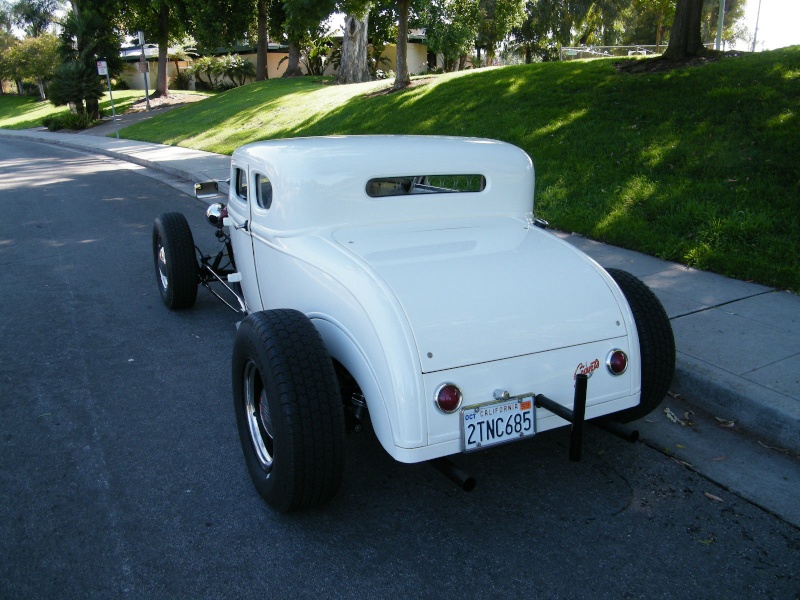
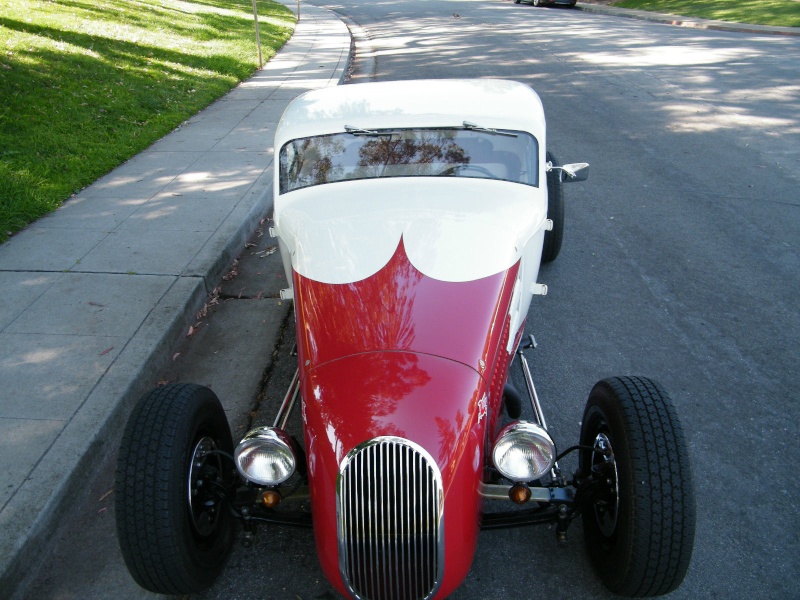
_________________
We don't care the People Says , Rock 'n' roll is here to stay - Danny & the Juniors - 1958
 Re: Hot rod racer
Re: Hot rod racer
_________________
We don't care the People Says , Rock 'n' roll is here to stay - Danny & the Juniors - 1958
 1925 T Speedster
1925 T Speedster
_________________
We don't care the People Says , Rock 'n' roll is here to stay - Danny & the Juniors - 1958
 1934 Shafer “8” Indianapolis Buick Powered Race Car SCTA INDY Pre-War
1934 Shafer “8” Indianapolis Buick Powered Race Car SCTA INDY Pre-War
1934 Shafer “8” Indianapolis Race Car!

Exacting copy of original
by Dennis Webb of Anaheim,
an old time craftsman of aluminum racing car bodies and chassis
working in So California since before the War.

‘38 Buick Century power plant; high performance cam, high comp head, special tuned exhaust,
‘38 Buick trans and rear end;
runs and drives excellently (request video)
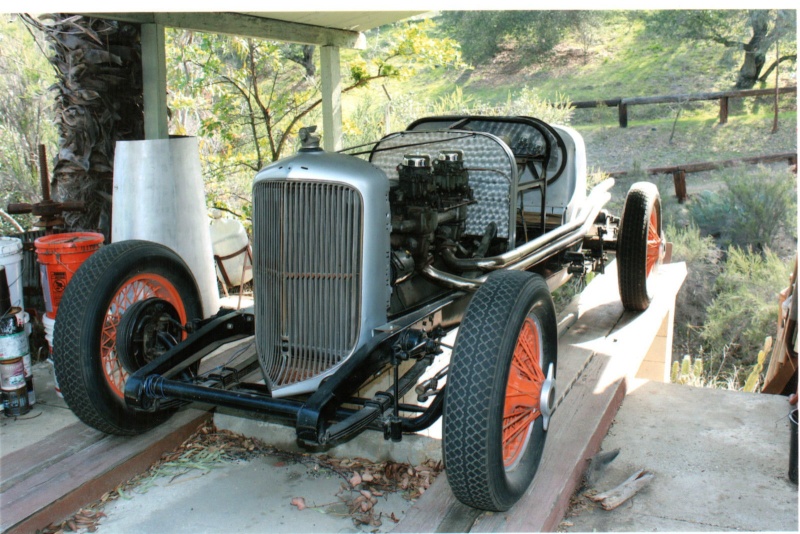
impressive exhaust note
all chassis components new and set up for street (or “Great Race” competition)
car is wired for headlights, taillights, turn signals, etc
correct Dayton knock-off wire wheels
full period instrumentation
needs paint, seat, upholstery

The 1934 Shafer “8” two-man Indy racecar
was car number #26 that year, driven by Phil Shafer
with the riding mechanic being Earl Frost.
Shafer had both Buick straight-8 & Studebaker 8 Indy cars entered
through the early 1930’s.

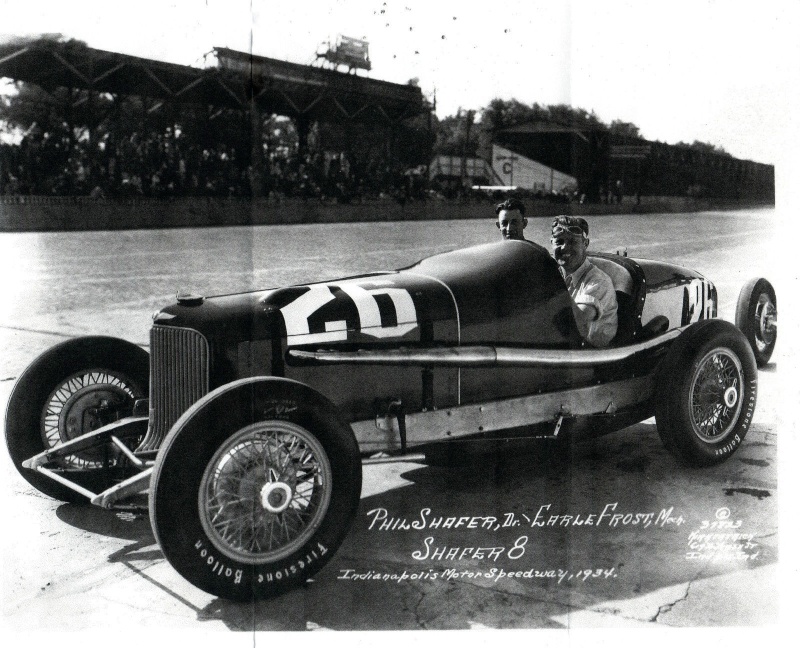

Exacting copy of original
by Dennis Webb of Anaheim,
an old time craftsman of aluminum racing car bodies and chassis
working in So California since before the War.

‘38 Buick Century power plant; high performance cam, high comp head, special tuned exhaust,
‘38 Buick trans and rear end;
runs and drives excellently (request video)

impressive exhaust note
all chassis components new and set up for street (or “Great Race” competition)
car is wired for headlights, taillights, turn signals, etc
correct Dayton knock-off wire wheels
full period instrumentation
needs paint, seat, upholstery

The 1934 Shafer “8” two-man Indy racecar
was car number #26 that year, driven by Phil Shafer
with the riding mechanic being Earl Frost.
Shafer had both Buick straight-8 & Studebaker 8 Indy cars entered
through the early 1930’s.


_________________
We don't care the People Says , Rock 'n' roll is here to stay - Danny & the Juniors - 1958
 Re: Hot rod racer
Re: Hot rod racer
_________________
We don't care the People Says , Rock 'n' roll is here to stay - Danny & the Juniors - 1958
 1951 Hot Rod - the famous ex Jim Hill "Barbecue Stove Bolt"
1951 Hot Rod - the famous ex Jim Hill "Barbecue Stove Bolt"
A once in a lifetime discovery --- the Jim Hill "Barbecue Stove Bolt" Hot Rod roadster constructed 1946 - 1951 in Vallejo, California and raced on the dry lakes. Incredible history pedigree and provenance entirely documented:

1951: Cal-Neva timing Association records (I have the trophies)
1952: Oakland Roadster Show major award winner entry # 207 (I have the trophy)
1953: "HONK Magazine" First feature car in very first issue of magazine later renamed "Car Craft." (I have the magazine)
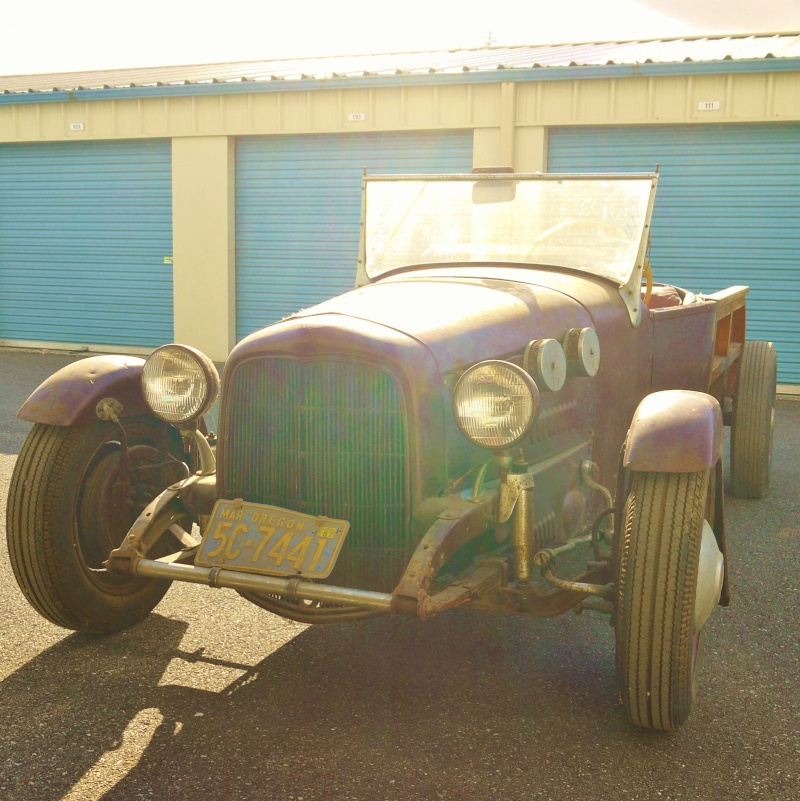
Car was then stored away in Oregon for nearly 50 years and is completely original, never restored, changed or messed with.
Discovered with many original spare parts including new piston, engine bearings in boxes dated 1948, rings etc. There is even a can of the original paint, with the label date coded Nov. '50 and the paint is still liquid. The tires still hold air. I have the original canvas convertible top and side curtains as shown in the original photos. I don't think anything is missing. "Harry Miller 3-port" Oldsmobile Head - please look at photos.

The May 1953 issue of HONK reads as follows:
----------------------------------------------------------------------------------------------------------------------------------------------------------------------------------
HYBRID HOT ROD
They Call This Pickup the "Barbecued Stovebolt" With Considerable Reason
Since 1946, Jim Hill of Vallejo, California, has had pieces of no less than 13 different makes or models of automobiles and at least one airplane. He and his father, E.C. Hill, put them all together during a six year span and wound up with a jewely little machine known as the "Barbecued Stovebolt."
Here's how the components figure:The body is from a '21 Dodge touring car, the chassis from a '27 Chevrolet. Brakes are '37 Chevy, grille is chopped '32 Ford.

In the engine compartment are a '28 Chevrolet block, 1932 Ford C crank, 1936 Pontiac rods pushing a set of Jahns pistons, a '30 Oldsmobile 3-port head equipped with Buda diesel valves and rocker arms scrounged from a 1938 Nash.
This is where the barbecue part comes in. To accommodate all the above parts, the block had to be built up in several sensitive spots. The center main web was filled in solidly and the rear main was rebuilt to fit a journal an inch and a half longer than the designer intended. All things considered, 26 pounds of welding rod and six bottles of acetylene were used.
This kind of thing creates considerable heat, so the Hills set the block in the family barbecue to cool for a total of four days.
When cooling had taken place, the block could be machined without fear of warpage. The final machining even took in a full pressure oil system complete to rifle drilled rods.

Externals on the engine include a cross drive from an airplane engine which when mounted on the front of the block drives a reworked Bendix magneto on one end and the oil pump system on the other. The oil system is full dry sump with oil scavenged from the crankcase and returned via a five gallon reservoir behind the driver's seat.
Another pump pulls oil from the tank and delivers it at 60 pounds pressure to the engine. An adjustable bypass keeps the pressure constant. Water cooling is handled by a 1924 Dodge water pump.
To complete the roster, the engine delivers it's power to a '46 Hi- Torque Chevy clutch to a transmission made up of parts from a Borg Warner unit, a military Jeep, a Nash and a Studebaker.

Hold on - we forgot; the starter is a six-volt unit from a '28 Chevy through which the Hills put 12 volts in order to turn the 9.5 to 1 compression ratio.
The Hills were rewarded in their project when the car took first prize for originality at the 1952 Oakland Roadster Show. Although the little honker was able to squeeze out only 84.4 at the lakes, the Hills feel it was over geared at a ratio of 2.54 to one and should do considerably better running a lower cog. As for us, we'll take it just as it is.

1951: Cal-Neva timing Association records (I have the trophies)
1952: Oakland Roadster Show major award winner entry # 207 (I have the trophy)
1953: "HONK Magazine" First feature car in very first issue of magazine later renamed "Car Craft." (I have the magazine)

Car was then stored away in Oregon for nearly 50 years and is completely original, never restored, changed or messed with.
Discovered with many original spare parts including new piston, engine bearings in boxes dated 1948, rings etc. There is even a can of the original paint, with the label date coded Nov. '50 and the paint is still liquid. The tires still hold air. I have the original canvas convertible top and side curtains as shown in the original photos. I don't think anything is missing. "Harry Miller 3-port" Oldsmobile Head - please look at photos.

The May 1953 issue of HONK reads as follows:
----------------------------------------------------------------------------------------------------------------------------------------------------------------------------------
HYBRID HOT ROD
They Call This Pickup the "Barbecued Stovebolt" With Considerable Reason
Since 1946, Jim Hill of Vallejo, California, has had pieces of no less than 13 different makes or models of automobiles and at least one airplane. He and his father, E.C. Hill, put them all together during a six year span and wound up with a jewely little machine known as the "Barbecued Stovebolt."
Here's how the components figure:The body is from a '21 Dodge touring car, the chassis from a '27 Chevrolet. Brakes are '37 Chevy, grille is chopped '32 Ford.

In the engine compartment are a '28 Chevrolet block, 1932 Ford C crank, 1936 Pontiac rods pushing a set of Jahns pistons, a '30 Oldsmobile 3-port head equipped with Buda diesel valves and rocker arms scrounged from a 1938 Nash.
This is where the barbecue part comes in. To accommodate all the above parts, the block had to be built up in several sensitive spots. The center main web was filled in solidly and the rear main was rebuilt to fit a journal an inch and a half longer than the designer intended. All things considered, 26 pounds of welding rod and six bottles of acetylene were used.
This kind of thing creates considerable heat, so the Hills set the block in the family barbecue to cool for a total of four days.
When cooling had taken place, the block could be machined without fear of warpage. The final machining even took in a full pressure oil system complete to rifle drilled rods.

Externals on the engine include a cross drive from an airplane engine which when mounted on the front of the block drives a reworked Bendix magneto on one end and the oil pump system on the other. The oil system is full dry sump with oil scavenged from the crankcase and returned via a five gallon reservoir behind the driver's seat.
Another pump pulls oil from the tank and delivers it at 60 pounds pressure to the engine. An adjustable bypass keeps the pressure constant. Water cooling is handled by a 1924 Dodge water pump.
To complete the roster, the engine delivers it's power to a '46 Hi- Torque Chevy clutch to a transmission made up of parts from a Borg Warner unit, a military Jeep, a Nash and a Studebaker.

Hold on - we forgot; the starter is a six-volt unit from a '28 Chevy through which the Hills put 12 volts in order to turn the 9.5 to 1 compression ratio.
The Hills were rewarded in their project when the car took first prize for originality at the 1952 Oakland Roadster Show. Although the little honker was able to squeeze out only 84.4 at the lakes, the Hills feel it was over geared at a ratio of 2.54 to one and should do considerably better running a lower cog. As for us, we'll take it just as it is.
_________________
We don't care the People Says , Rock 'n' roll is here to stay - Danny & the Juniors - 1958
 Re: Hot rod racer
Re: Hot rod racer
_________________
We don't care the People Says , Rock 'n' roll is here to stay - Danny & the Juniors - 1958
 Re: Hot rod racer
Re: Hot rod racer
_________________
We don't care the People Says , Rock 'n' roll is here to stay - Danny & the Juniors - 1958
 Re: Hot rod racer
Re: Hot rod racer
_________________
We don't care the People Says , Rock 'n' roll is here to stay - Danny & the Juniors - 1958
 Re: Hot rod racer
Re: Hot rod racer


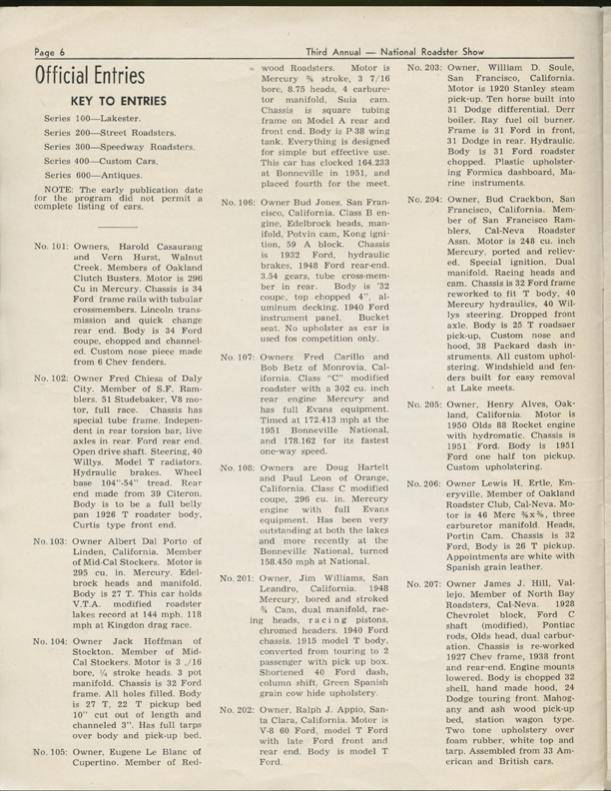
_________________
We don't care the People Says , Rock 'n' roll is here to stay - Danny & the Juniors - 1958
 Re: Hot rod racer
Re: Hot rod racer
_________________
We don't care the People Says , Rock 'n' roll is here to stay - Danny & the Juniors - 1958
Page 3 sur 6 •  1, 2, 3, 4, 5, 6
1, 2, 3, 4, 5, 6 
 Sujets similaires
Sujets similaires» European Racer
» L'Etoile Filante - Renault racer
» Sport car racer
» Saltflat Racer - Hot Wheels
» Track T - Ford T Hot rod hi-boy racer - Hot Wheels
» L'Etoile Filante - Renault racer
» Sport car racer
» Saltflat Racer - Hot Wheels
» Track T - Ford T Hot rod hi-boy racer - Hot Wheels
Permission de ce forum:
Vous ne pouvez pas répondre aux sujets dans ce forum
 Connexion
Connexion







